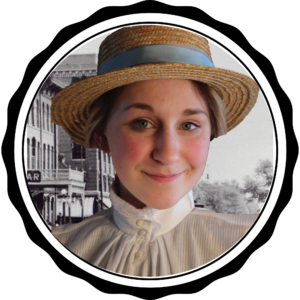
Bailey Phillips, 1902 Secretary in Cheyenne, Wyoming

Character Development of a Wyoming Woman

Bailey is a high school student with aspirations to become a successful writer, and has already won awards for her fiction. When she heard we wanted to develop a character that would depict the “New Woman” of the turn of the 19th Century into the 20th, she jumped on the opportunity. Growing up in a family experienced in law and politics, it was a perfect fit to create a young character who would go into the “family business”.
We also have had requests to put on “all Wyoming” or “all Western” shows that feature the attitudes and fashions of women of the west. Since Silhouettes builds only for non-indigenous American women, that means a true Wyoming woman’s story might begin from anywhere, but to describe her life in Wyoming, it has to start somewhere around 1840, and more likely 1869 when Wyoming was formally recognized as a state.
The history of the territory, state, towns, cities, farms, and ranches comes into play greatly in developing a character in Wyoming. It is a complex story of migration, economic development, politics, and technology. It is a study in the “why’s” of people – why did they leave the comfort of the eastern cities? Why did they face hardships in creating their own businesses? Why did they staty and what did they do?
Development of the “New Working” Woman
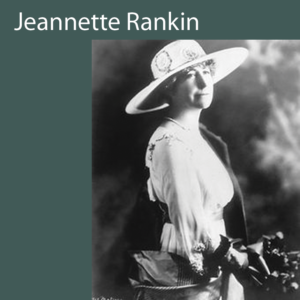
The year 1902 in America was called the “Time of the New Woman”, and we add after our study up to this point – “at last”. Women had been in and out of the work force; they had in fact been running businesses, farms, households, organizations, and their own lives for centuries. The story if you follow women in the workplace on a timeline however, has ups when women were recognized and emulated, followed by downs where a new ideal such as the demure damsel in distress would arise such as in the 1880’s.
It seems 1902 had women “finally arriving” so that the new “Normal Woman” was one who worked or ran things outside the home, although she was still running the home too. Bailey’s character will be such a woman. She will be very young – they married young and they died young, although health and longevity had much improved by now. This Bailey will be born into Wyoming – not immigrated to it as her parents or grandparents might have been. This would make all the difference as 3rd generations typically are. She precedes the dominate homesteading patterns, and follows the settlements of major cities.
She would be curious, innocent, and single. She would have an internal drive to prove that women CAN and WILL succeed by their own merits. She will also have someone watching out for her, for the “New Woman” was not alone – the men in her life would make sure of it.
Click here to go to Bailey’s Historical Context Page (Next)
Click here to go to Bailey’s Fashion & Women’s History Page
Click here to go to Bailey’s Design Development Page
Continue below to see the Finished Project:

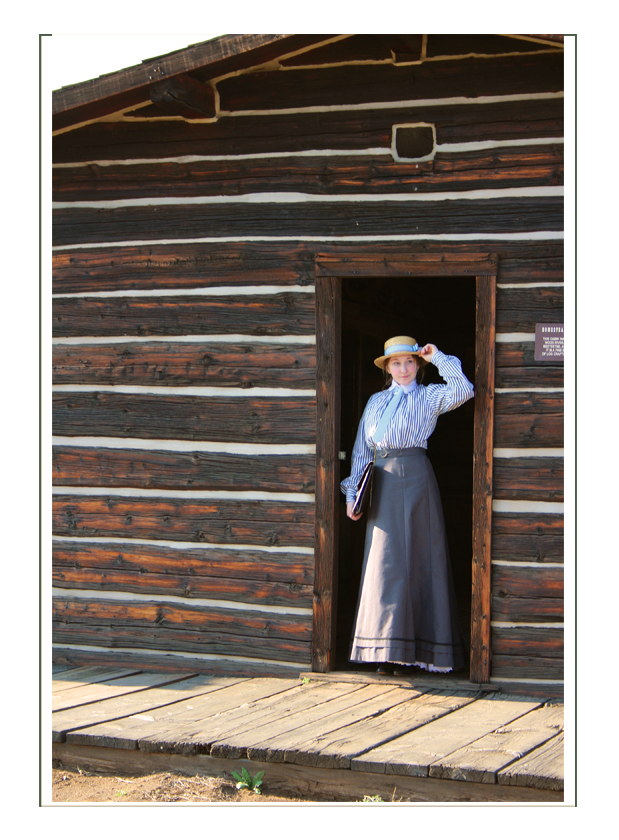
 (See the History & Design pages for the development of the project up to this point). The Working Woman ensemble of Bailey’s character represents key features:
(See the History & Design pages for the development of the project up to this point). The Working Woman ensemble of Bailey’s character represents key features:
- young
- single; on her own
- living with someone yet self sufficient & self supporting
- practical and functional version of high fashion of the day
- representing a conservative taste with a bit of a flair of uniqueness
- wanting to blend in with the men & to get along in a male dominated world
- easy to wear; durable and inexpensive
- made more for “sport” than fashion; as opposed to the Edwardians of the day who focused on not working – everything about this must say “working hard”
- accessories and trims; fabrics and colors consistent with the specific year
- skirt design and gores changed every season; this must be exact
- some flexibility so that additional outerwear or alternate blousewaists, etc. can be worn – just as she would have done
- very basic undergarments; mass produced and “cheap”ly made without alteration (we can assume she can’t really sew or cook well)
- adding “tools of the trade” – writing, paper, books, and stenography
- she has to be able to type and take dictation; have all the characteristics of a good resume for a man’s personal secretary
The Design
At this point we have narrowed down the silhouette, accessories, and overall design (see Design Development pages). All we need to do is choose from the vintage and authentic items, fabrics, and notions from among the choices we already narrowed down from everything in the whole world. The first choice is color scheme.
Based on research on fabric and color, Burgundy, black, dark blue, or dark gray are the obvious choices. That’s all that is seen in extant garments for the year. Because of the personality trait that she is “conservative” (meaning taught with a religious background and upbringing of the same, she tends to choose sedate colors and styles), and that she feels the need to “blend in” with men – she would choose the man-like black suit.. or gray in this case.
Personality will be expressed through changing accessories.
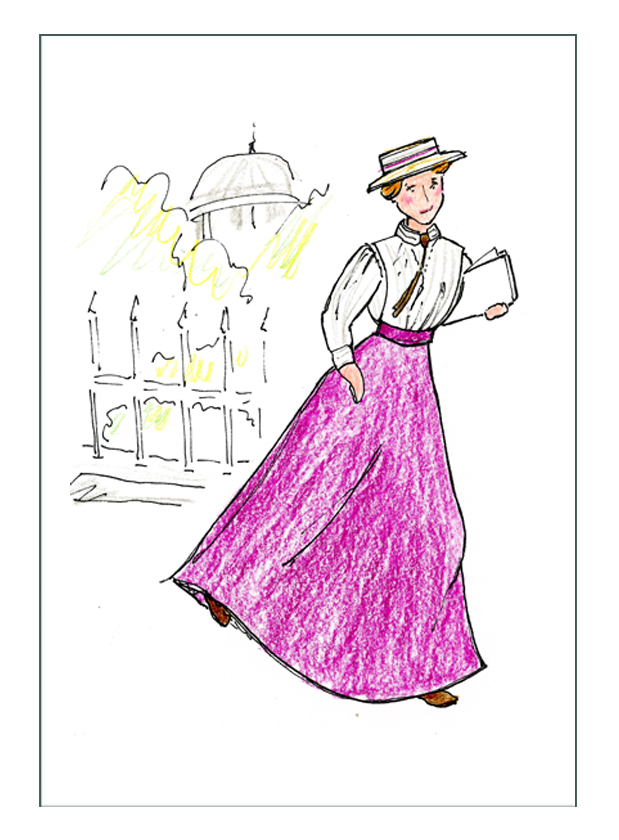


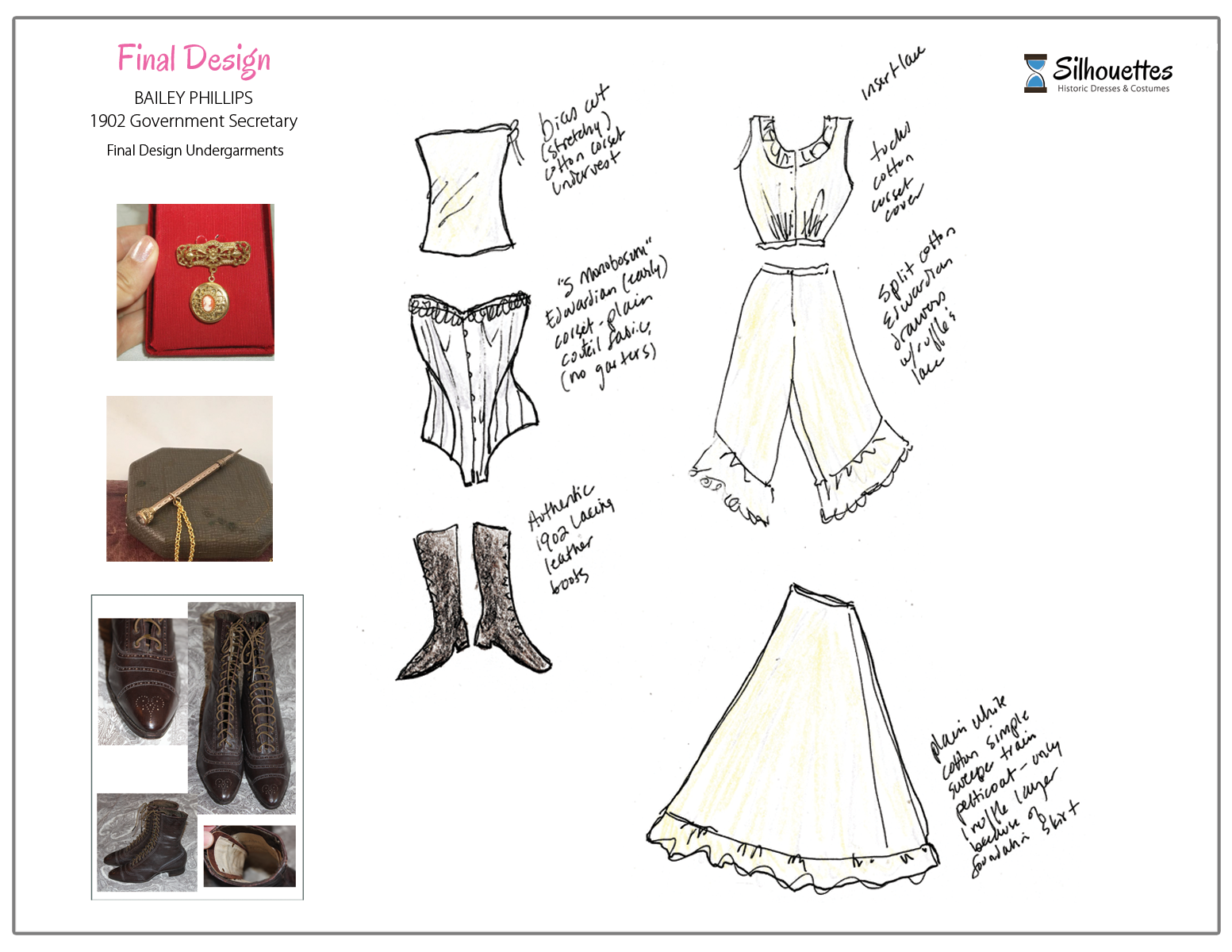 Simple, classy, basic, and interchangeable are key words for every item in this ensemble from a catalog type petticoat, somewhat outdated (authethentic!) boots, to a plain dark gray skirt and tailored blousewaist.
Simple, classy, basic, and interchangeable are key words for every item in this ensemble from a catalog type petticoat, somewhat outdated (authethentic!) boots, to a plain dark gray skirt and tailored blousewaist. Final Choices
Final Choices
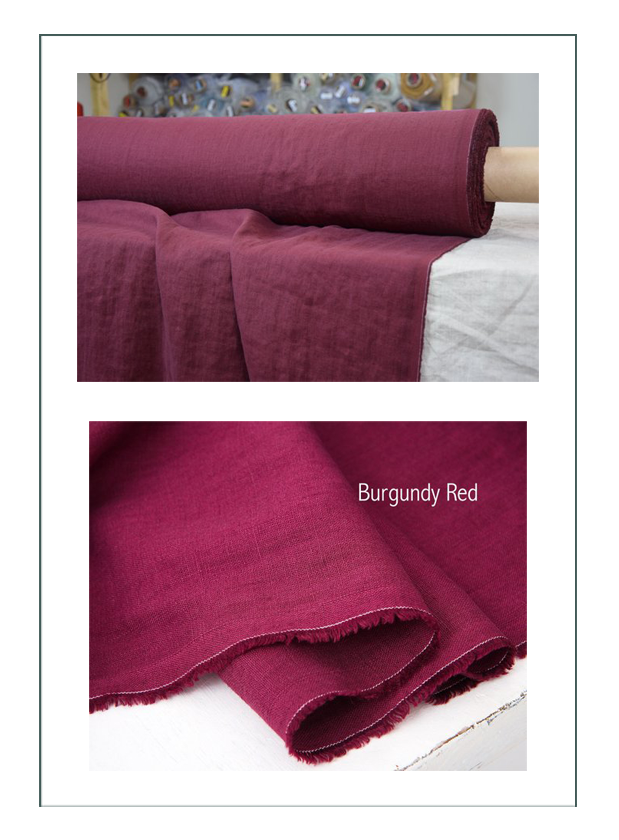
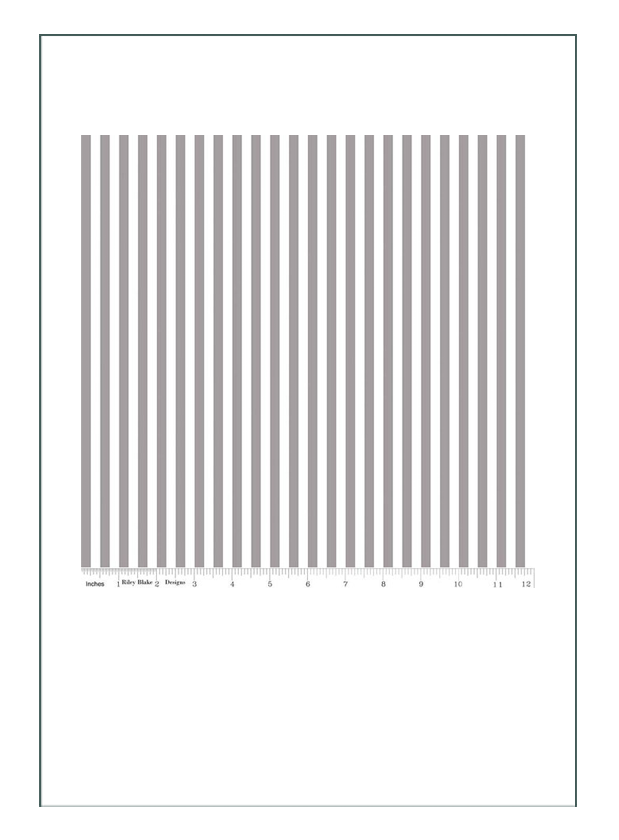
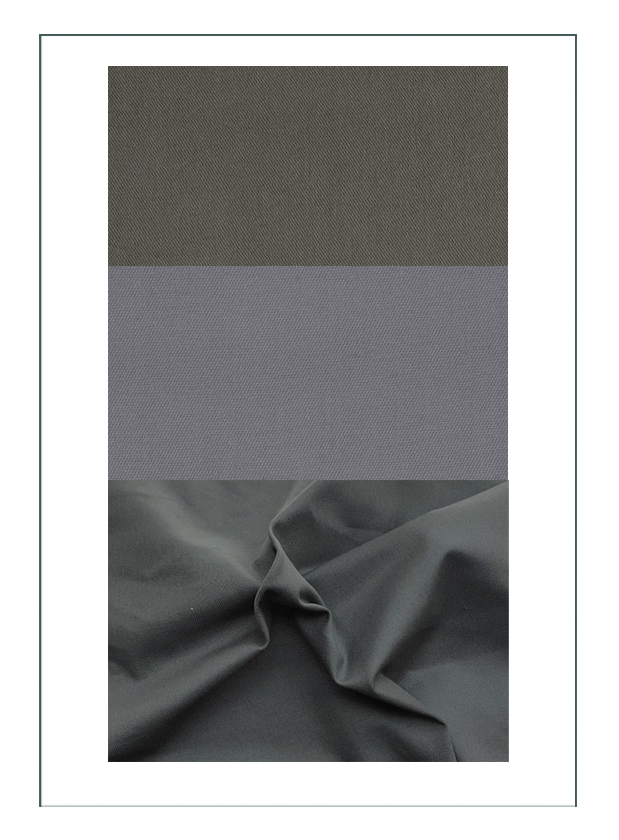
Final Fabric Decisions
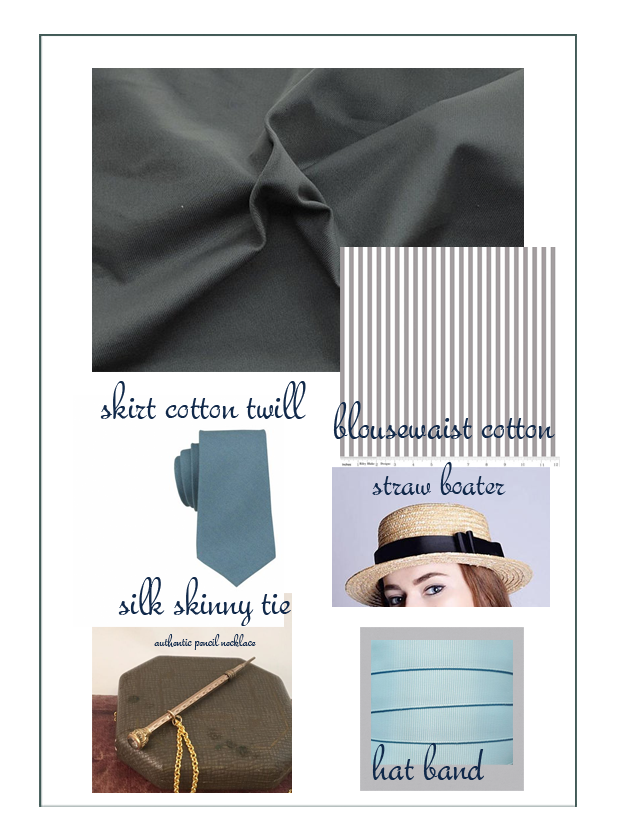
Final Notions Selections
In stock we keep period, vintage, and authentic notions such as cameos and buckles. We had this PERFECT 1900 brass buckle – a “cheap” and very small one for a very small woman.
Actually, Bailey and her size were quite average for 1902, which we find when trying to buy or study extant garments and footwear. It’s modern women who are huge. These are suitable for a small and young working woman who is trying to impress on a budge.
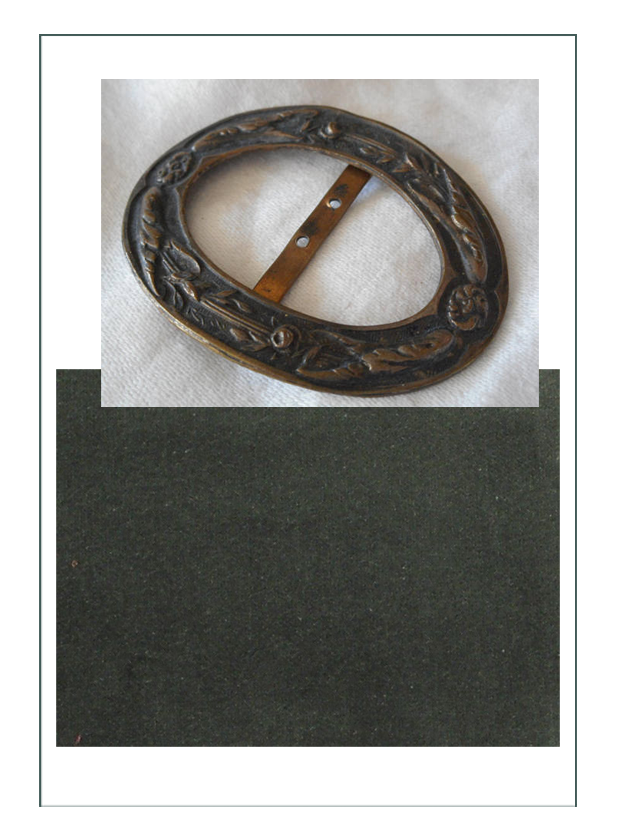
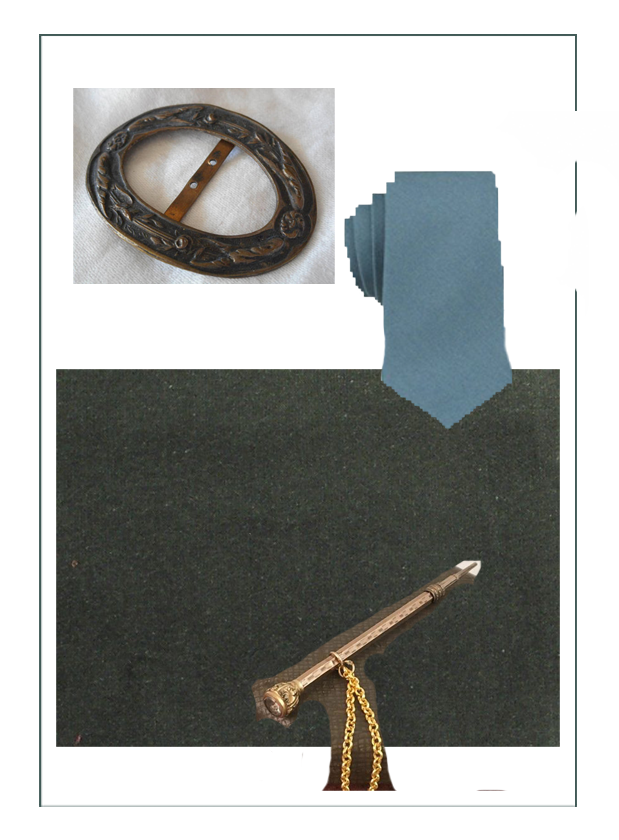
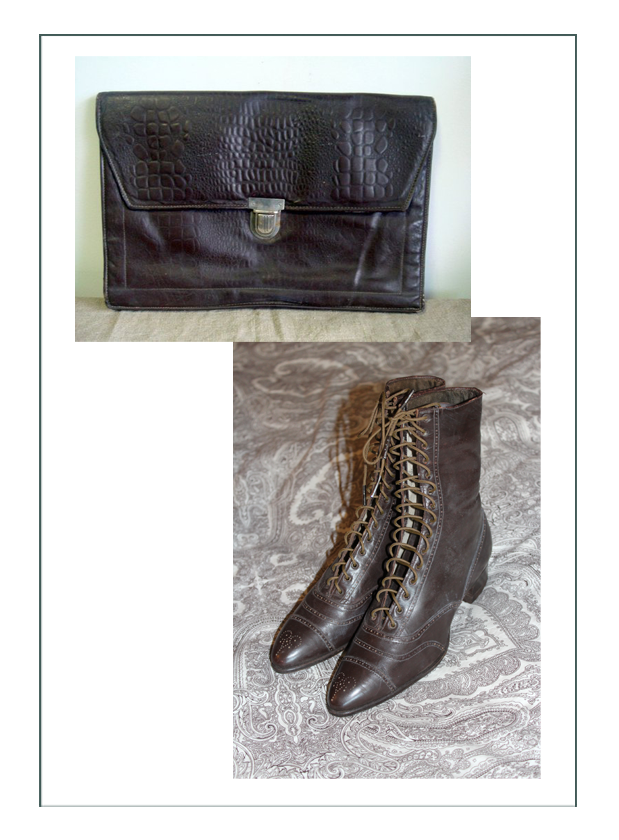 The briefcase was a “second thought” after the design had been completed. When sketching, we needed her to be carrying something to work. We went through actual photos of 1900-1906 and found wonderful examples of portfolio briefcases women from around the world were carrying to their jobs. It is only logical Bailey’s would be of leather (living in a cattle city), and might have been a gift from her parents for good luck when she left home. Perhaps it was father’s old ones from his intern days.
The briefcase was a “second thought” after the design had been completed. When sketching, we needed her to be carrying something to work. We went through actual photos of 1900-1906 and found wonderful examples of portfolio briefcases women from around the world were carrying to their jobs. It is only logical Bailey’s would be of leather (living in a cattle city), and might have been a gift from her parents for good luck when she left home. Perhaps it was father’s old ones from his intern days.

Photos will show 1st fitting on mannequin in the shop, and then the 2nd fitting on Bailey. At that time we noted the skirt was way too long, but everything else was perfect! The resulting modification of the design of the skirt turned out to be an exciting improvement, and made it even more accurate to 1902. We add a dark gray matching gimp braid, and a tuck at the bottom that followed the design. The result was phenomenal. These photos were taken at the fittings and during a photo shoot in Cody, Wyoming downtown at Buffalo Bill’s Irma Hotel which was built in 1902! and in front of authentic 1902 cabins.
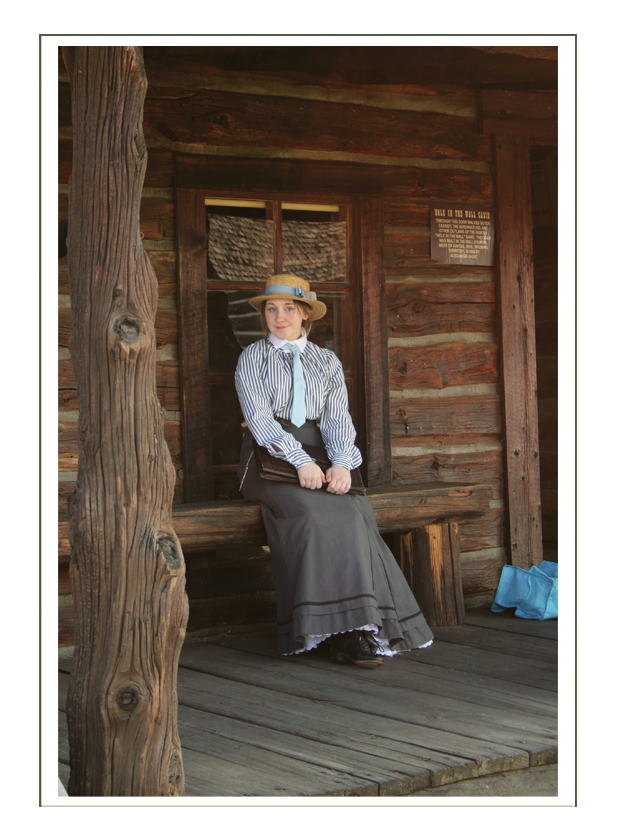
 Monobosum Corset
Monobosum Corset
This includes rump and two breast pads. The pads are put below the breasts to fill out the corset, and are in no way used to lift or separate the breasts as in previous fashion eras. There will be some lifting in younger girls, but older women will let their breasts slide into the gores of the corset. The rump pad is tied securely to the corset lacing in back, and not around the waist as our modern mind thinks it should be. That keeps it from sliding over the hips, and from being smashed by the strings in attempt to keep it up.
CORSET ON THE MANNEQUIN
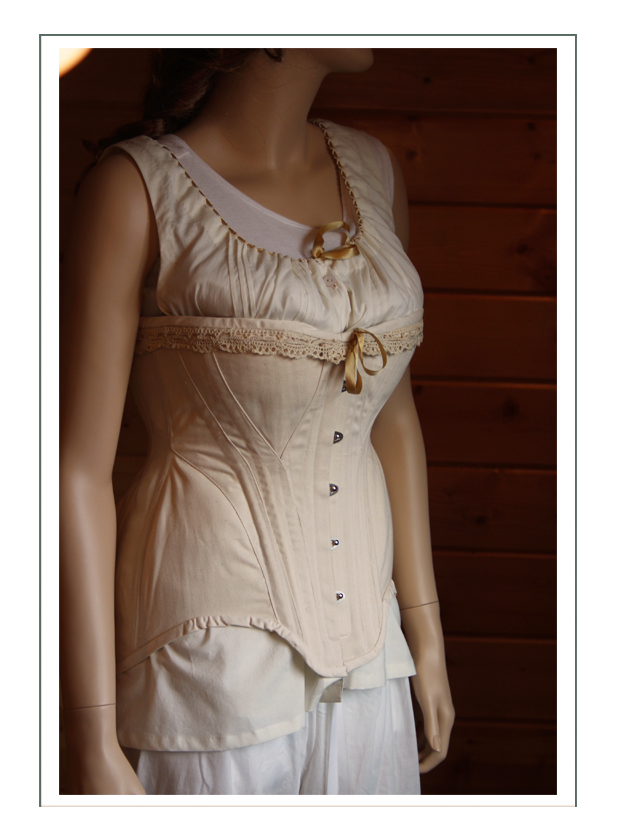
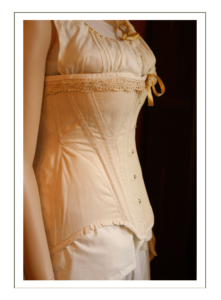
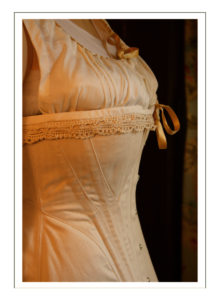
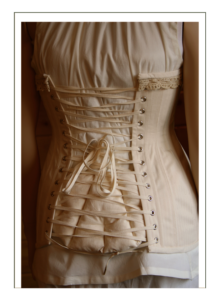
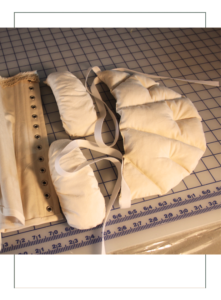
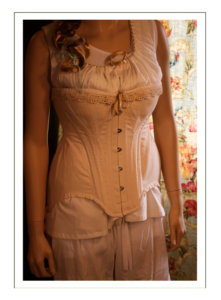
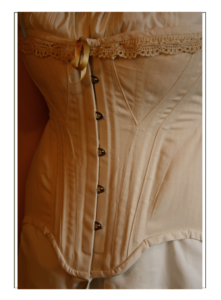
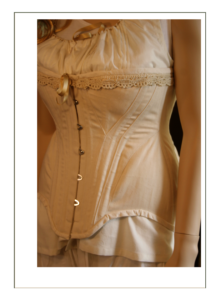
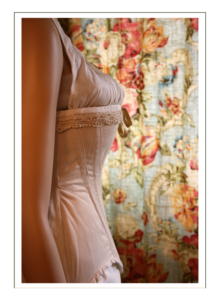
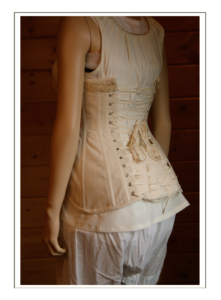
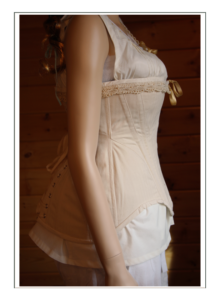
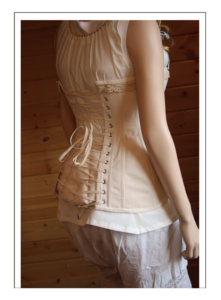

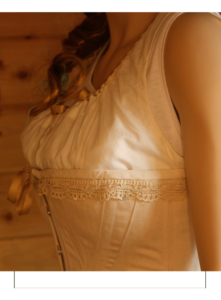
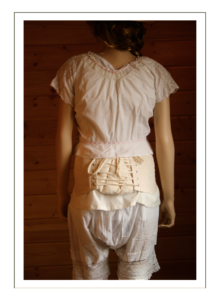
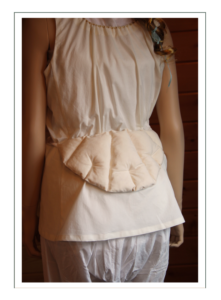
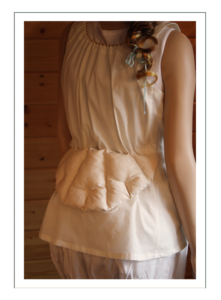
CORSET ON BAILEY
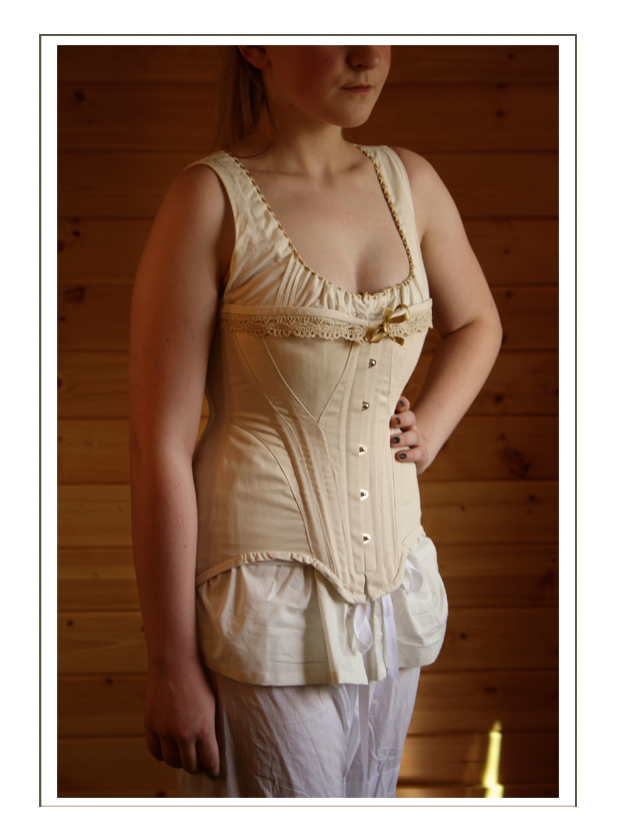
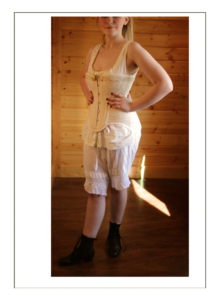
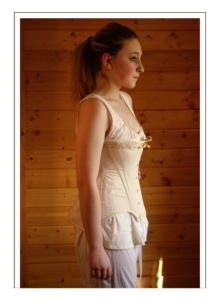
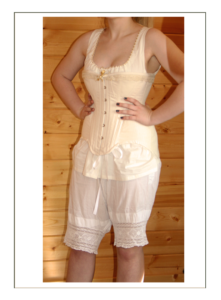
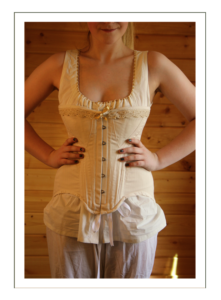
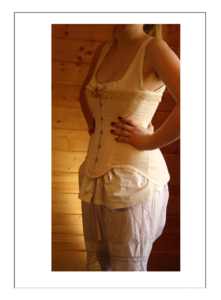
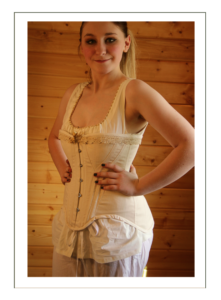
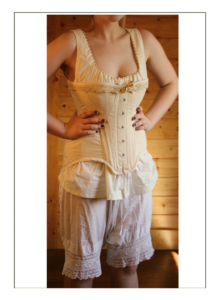
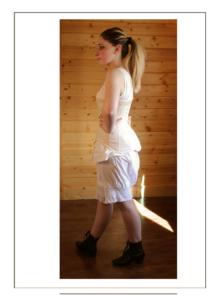
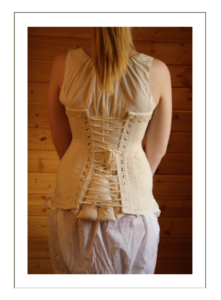
Camisole
This has 100% cotton lace and GORGEOUS gold 100% silk satin ties that remind one of boudoir, yet are actually very functional because they will not rip or come untied like synthetics or cotton. What we think is most special is the huge bow of silk, mother of pearl buttons, but mostly, the so very Edwardian tucks across the front that help get that “pouched” silhouette. This is cut long to protect from chafing by the long corset edges, but short enough it won’t impede use of either a split drawer OR for the first time, a pull down drawer for use in the “necessary”.
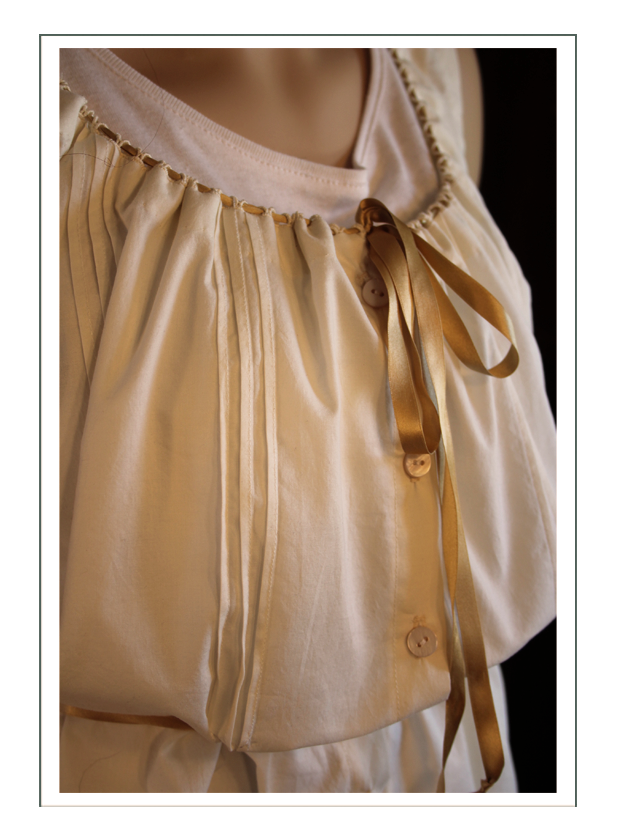
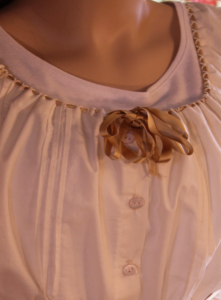
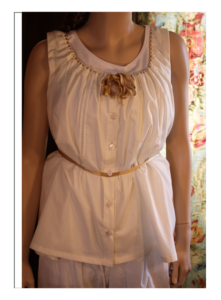
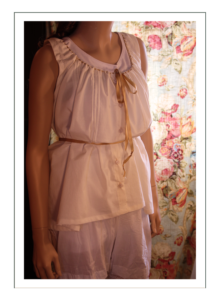

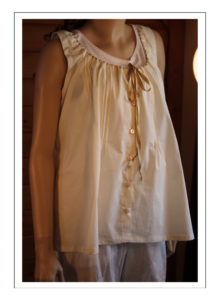
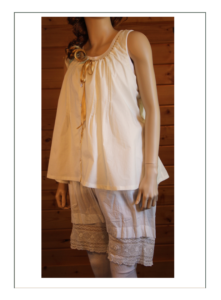
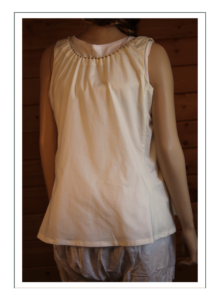
Authentic Corset Cover
This goes OVER the corset, while the camisole goes under. We found this gorgeous actual 1902 extant wearable example, and all we had to do was replace the lacing string with silk. It is worn as the sweat absorbing layer and to protect the outer garments from the metal of the corset. Just look at the gorgeous insert lace on sleeves and center front!
ON MANNEQUIN
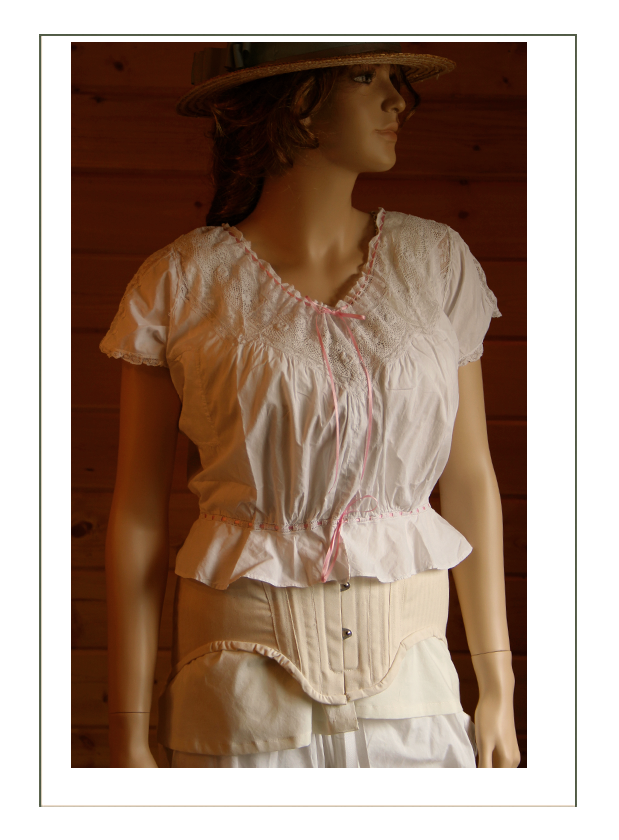
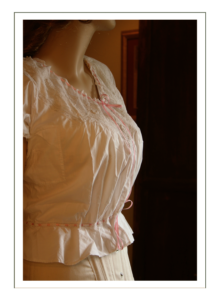
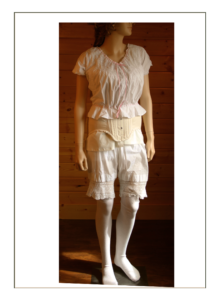

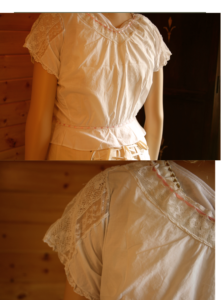
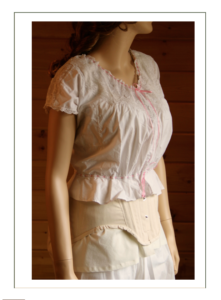
ON BAILEY
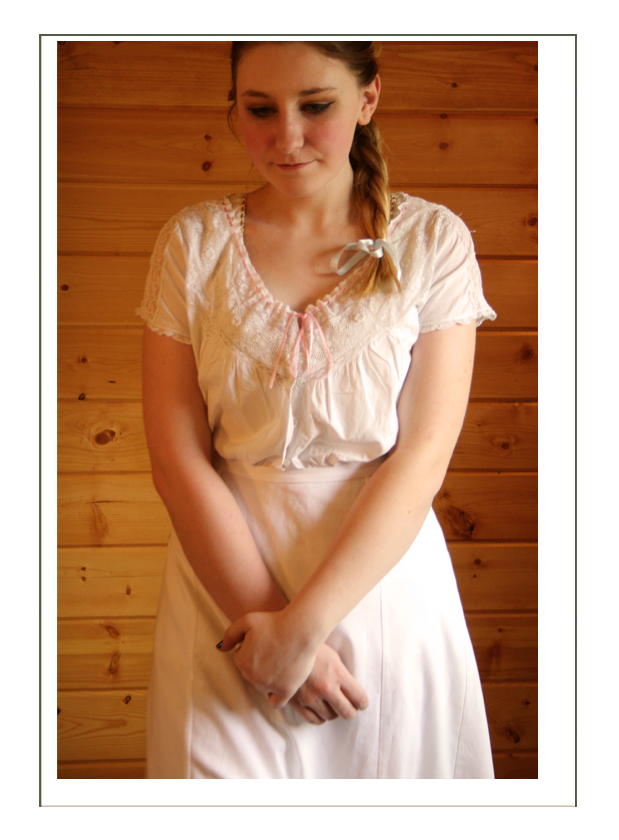
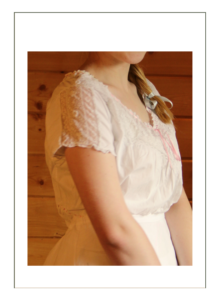
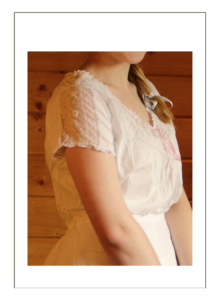
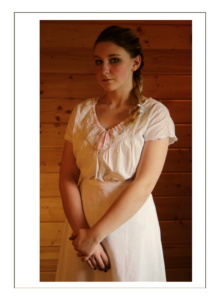
Authentic Split Drawers
These too were a rare find, from 1902, the year of our depiction, they are a perfect fit. They had been split, but someone had patched them up to be non split – very typical of this change over from Victorian to Edwardian. Victorians almost always wore their drawers under their corsets, so they could not possibly pull them down. Starting around 1900, but more typically from 1905 on, the drawers could be worn OVER the corset, and thus be able to pull them down. This was more applicable once the waistband dropped below the corset line, than at this time when the waist of the skirt would have made it hard. Bailey wore them at her hips over the corset so she could pull them down. Notice the gorgeous Edwardian lace and tucks on these too! That’s the edge of the camisole you are seeing through the sheer fabric.
ON MANNEQUIN
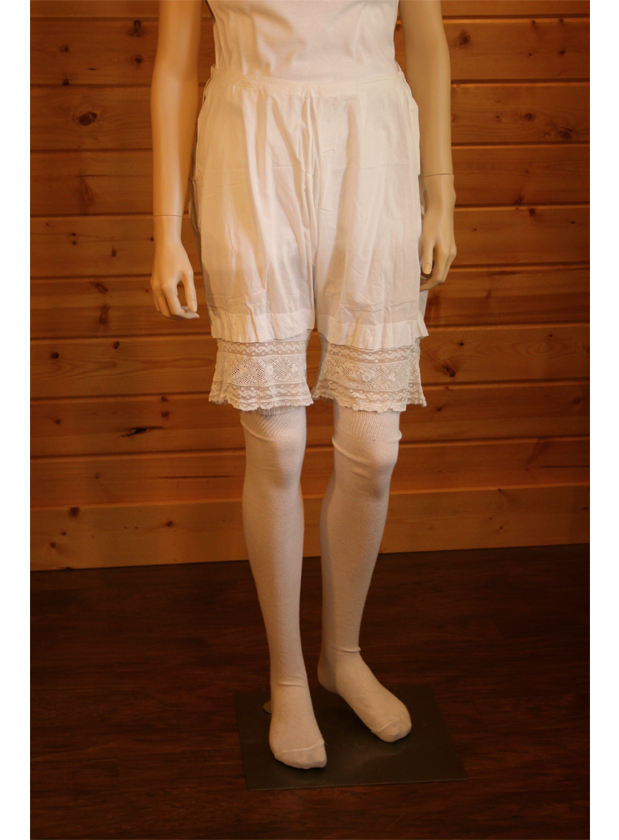
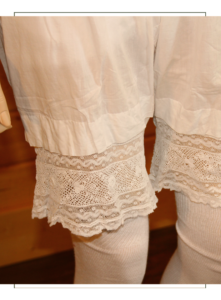
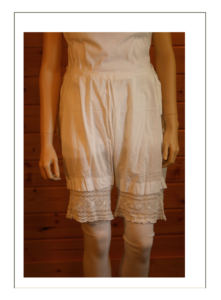
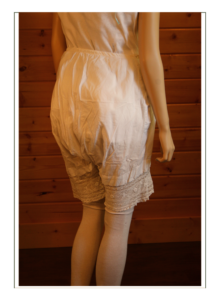

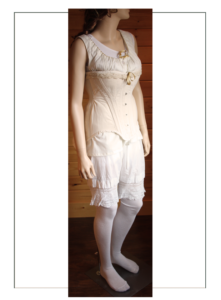

ON BAILEY
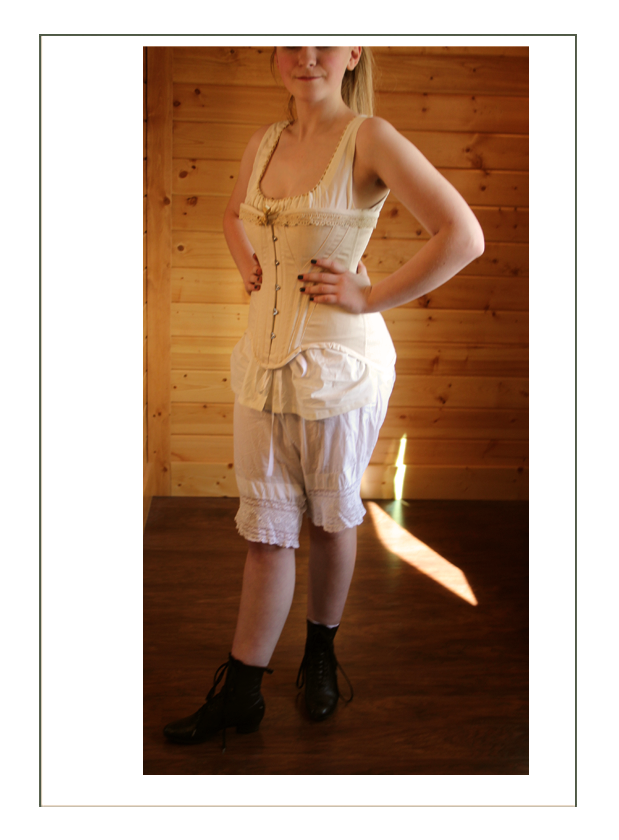
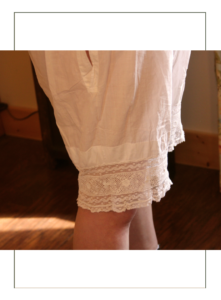
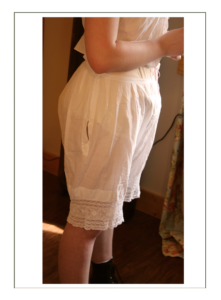


Petticoat
Remember this is a “sweeper train” petticoat. It intentionally sticks out at the back and moves side to side when she walks, “sweeping” the sidewalk. For this reason it is built with durable and washable facings on the bottom of the hem, and the whole thing is very washable. Note the high quality 100$ cotton broiderie lace on the ruffles and over the joining seam. There was one thing Edwardians thought was vulgar, and that was a seam showing (thus the insets of lace and overlapping and tucks on everything). This lace and ruffle over what would be a huge and visible seam is VERY Edwardian! Just look at how the skirt moves as she walks, and creates the early Edwardian silhouette even when standing still. It is so much fun to move in! So feminine.
ON MANNEQUIN
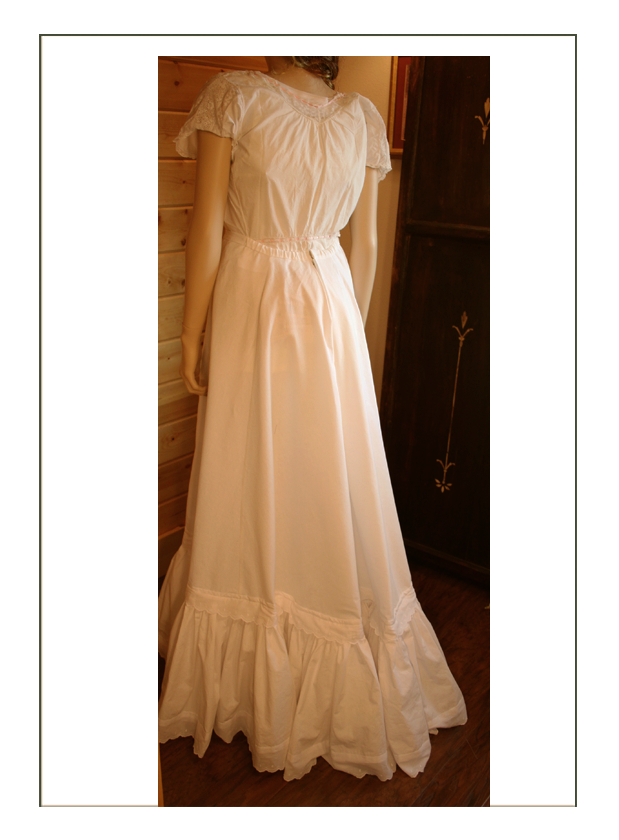
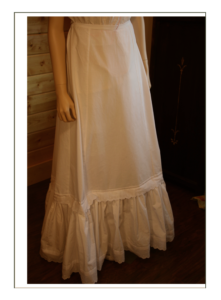
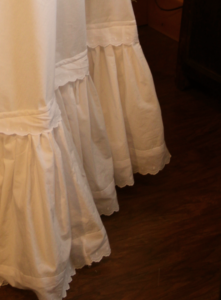
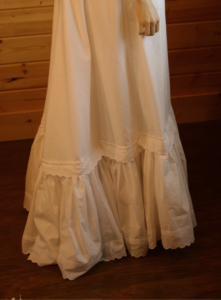
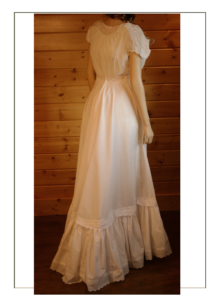
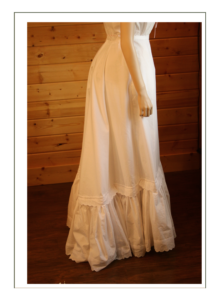
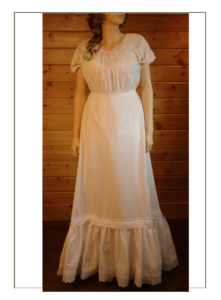
ON BAILEY
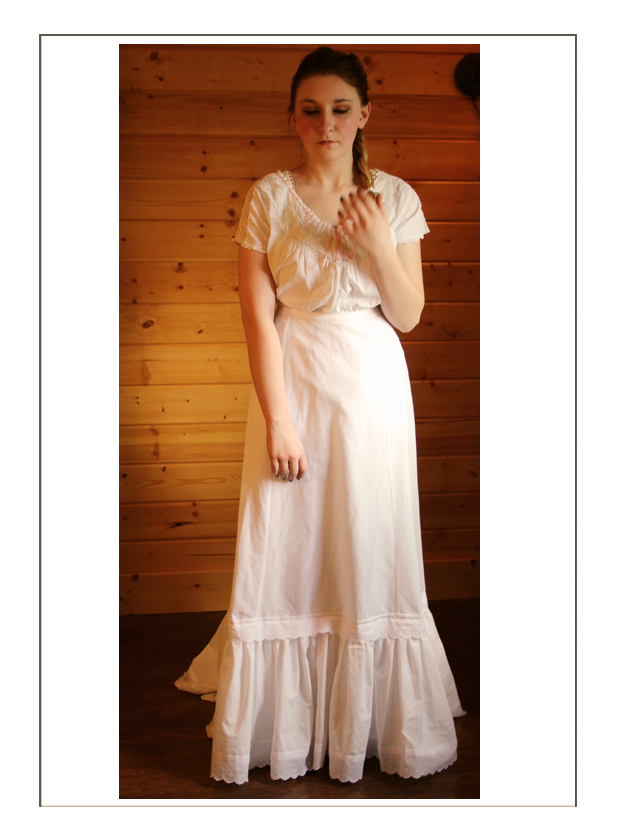
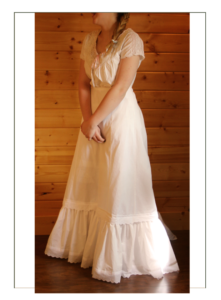
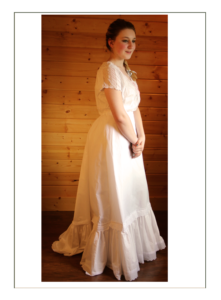

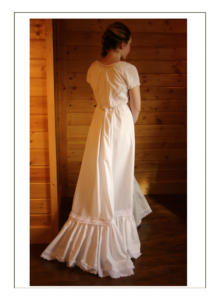
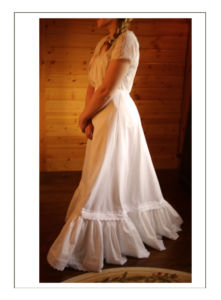

Blousewaist
Remember here too, this is the Edwardian “monobosum” era, where she is supposed to look like a pigeon with his breast puffed up. It is the first time in history the “suit” was 3 different pieces: jacket, skirt, and blousewaist (not a blouse or a shirt! It was a big deal to call it something other than a “bodice” as it had been the prior century). The detachable collar and cuffs are notable of the design and specific to the era. A young working girl would wash her collar and cuffs, but not her other outer garments.
ON MANNEQUIN with and without collar and cuffs
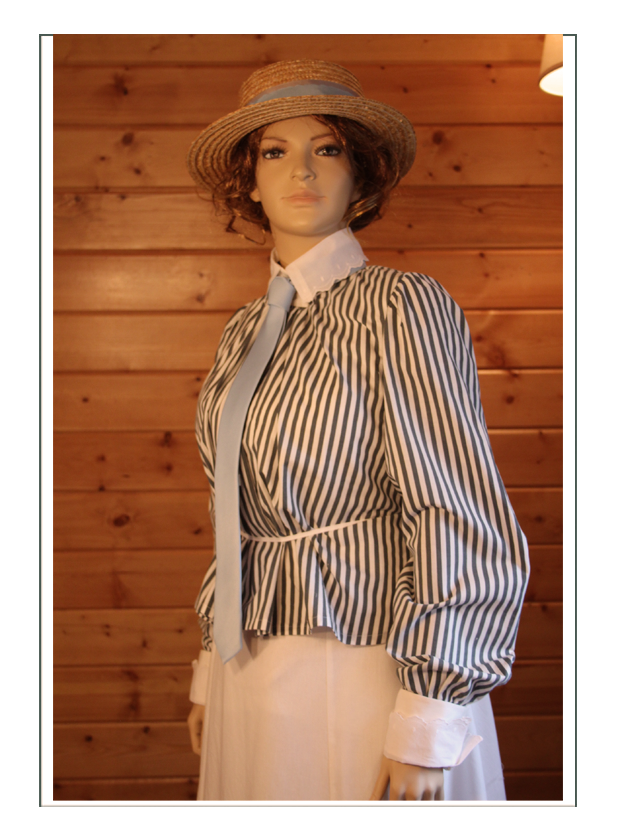
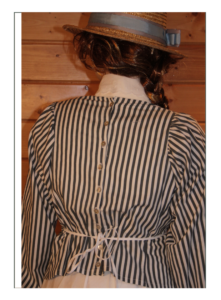
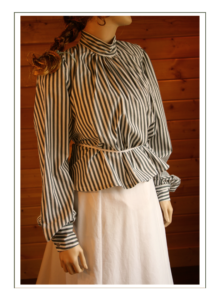


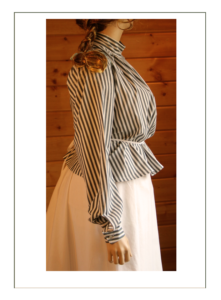
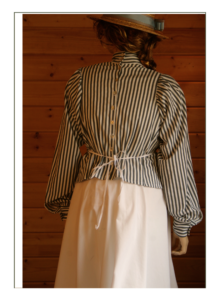
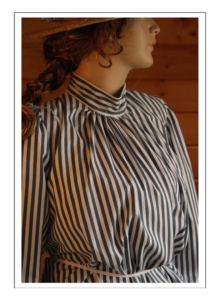
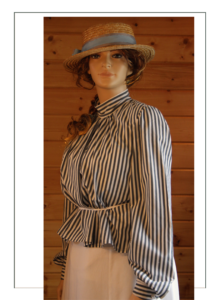
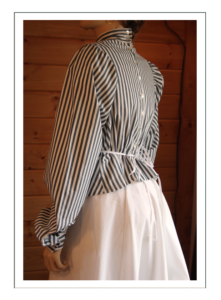
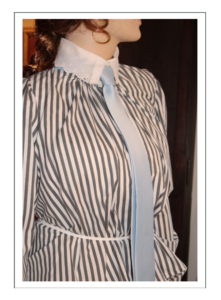
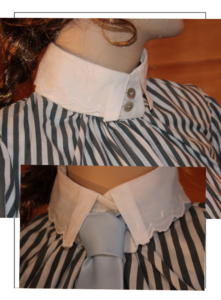
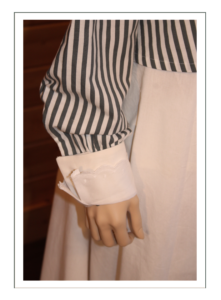
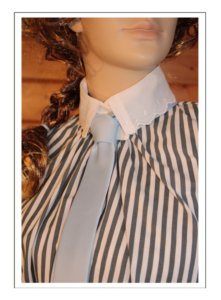
ON BAILEY with collar (she doesn’t like the cuffs)
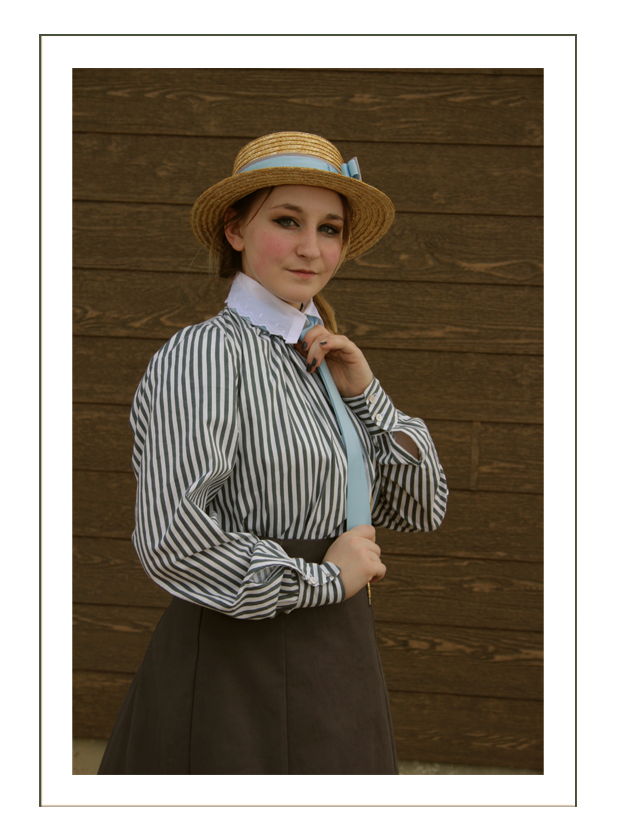
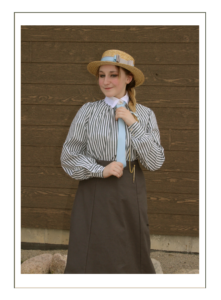
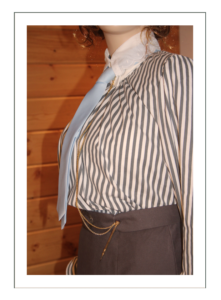
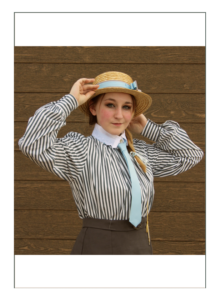
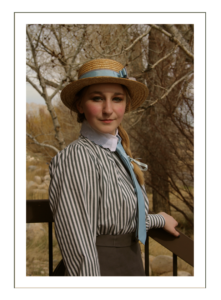
Skirt
The finished product was a happy surprise in adding the tuck and trim to fit. the deep pleat in back works with the sweeper petticoat to give fullness and movement in the back. The skirt stays in this shape, because it’s made in this shape and supported by the undergarments. It is no accident.
ON MANNEQUIN
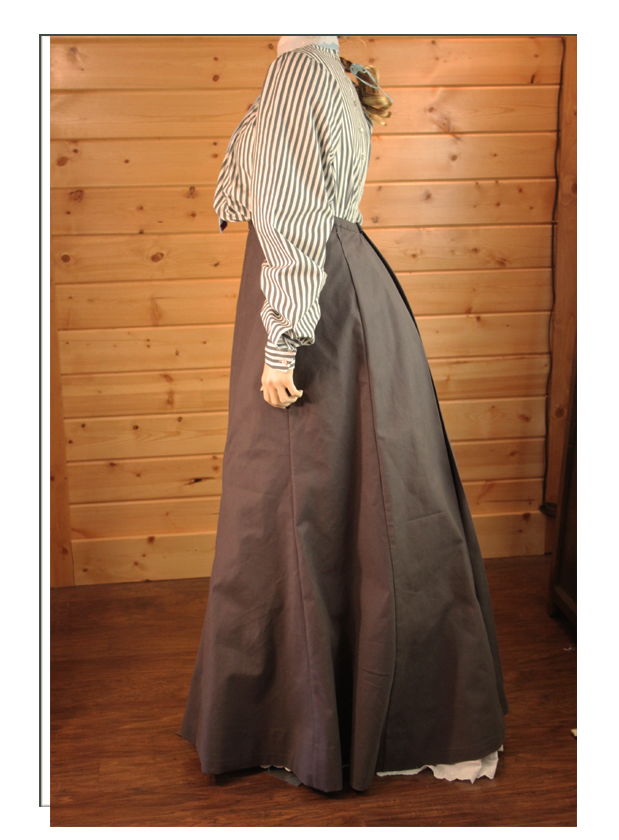
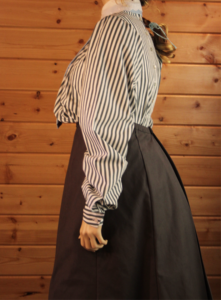
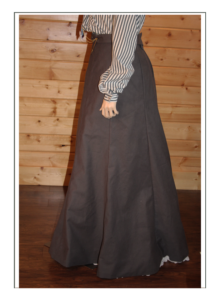

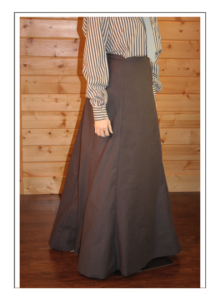
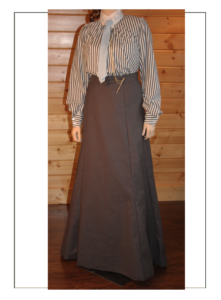
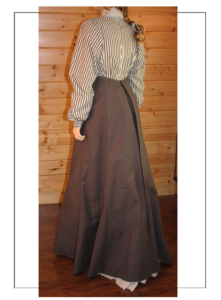
ON BAILEY
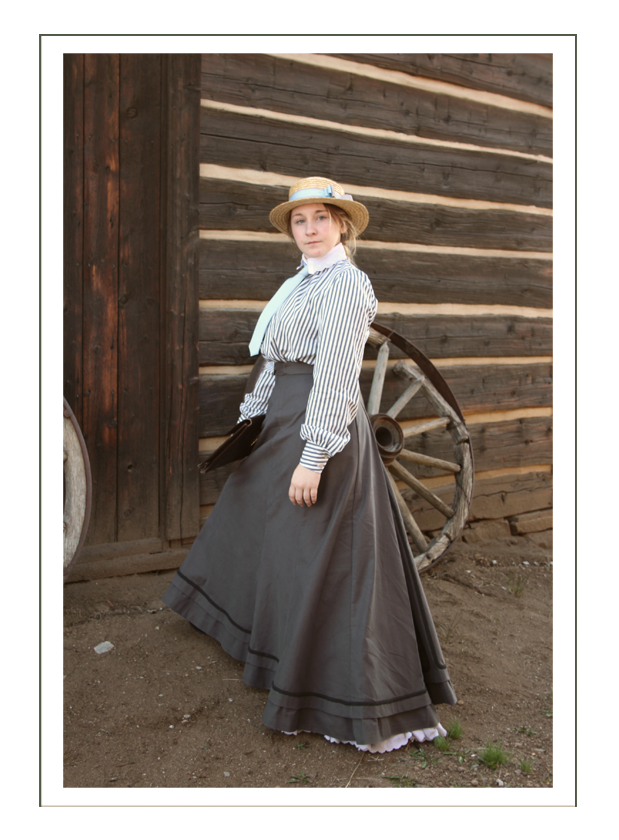
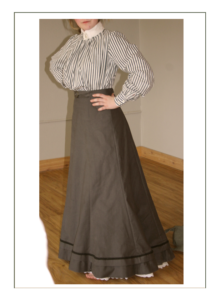
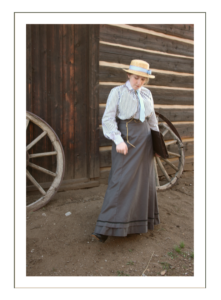
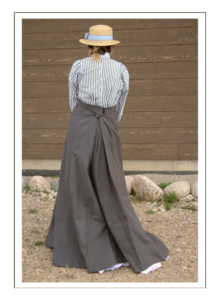
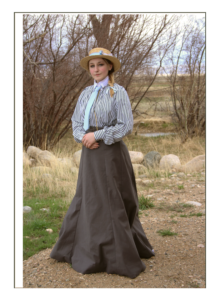

Sash (Belt)
This is handmade of self-fabric from the skirt. While most sashes of the day were a contrast, for work wear, they were equally often of same fabric like men wore. This one has an antique 1900 buckle, and we added silk buttonhole twist belt loops to hold it firmly in place, and so it actually does the work of holding up the very heavy skirt. The back of the sash features giant hooks and eyes as a designer accent, but we had to modify this smaller for Bailey. The modified version does not show the hooks, and neatly butts up the two ends so it looks like a regular belt. Since the “buckle” is actually not a buckle, but a sash brooch such as Celts would wear on their shoulder, the front is only decorative, while the back hooks are operative.
We also use the belt loops to hook the pencil on, or a woman might put her watch there.
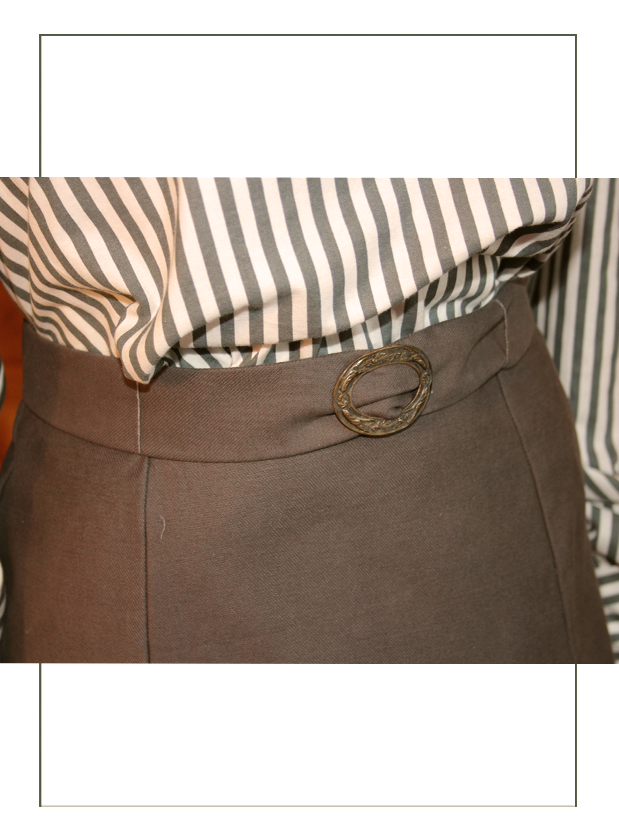
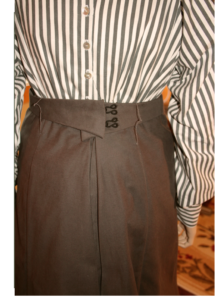
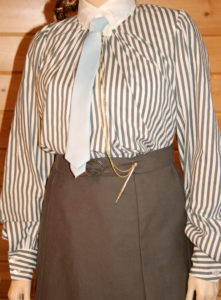
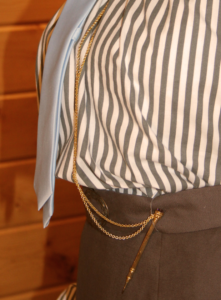
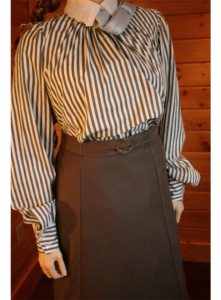

Boots & Stockings
Bailey wears different boots for different events. She has a late 1890 walking boot for her work, and an Edwardian boot with heels. She selects from what is available in her size for each fitting. The skirt is designed to accommodate a 1″ heel though.

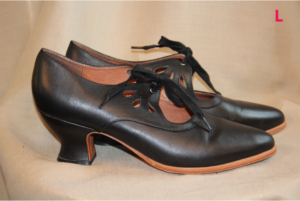
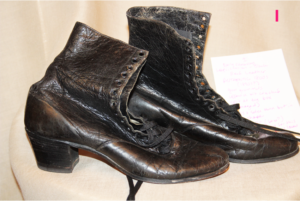
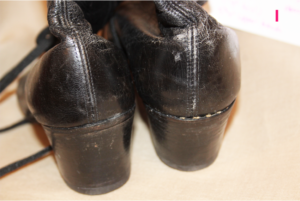
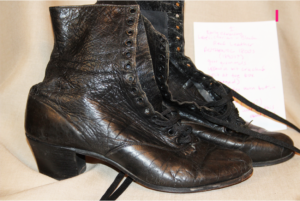
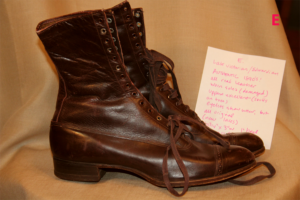
Jewelry
Very special to this ensemble is the authentic 1902 mechanical pencil! She might also wear a simple victorian pair of earrings, but we did not provide them for this ensemble.

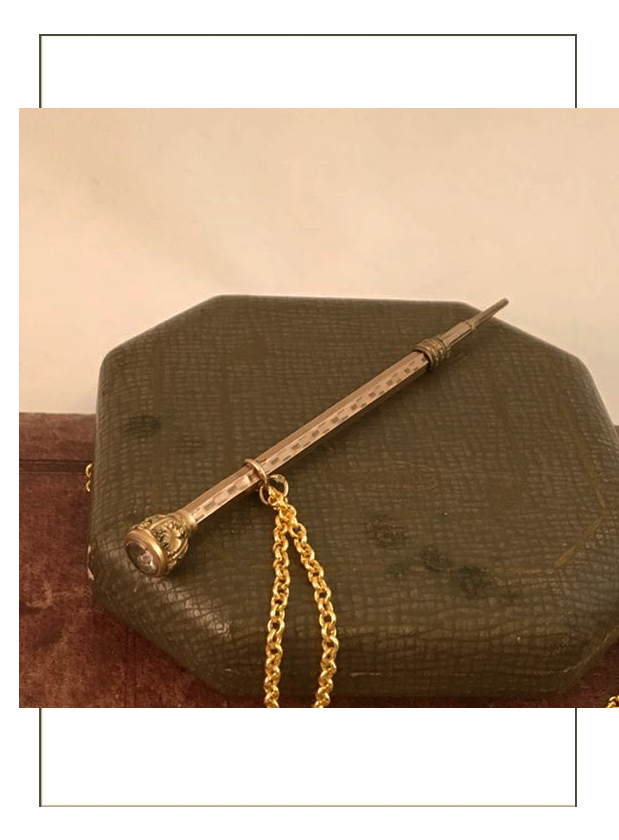
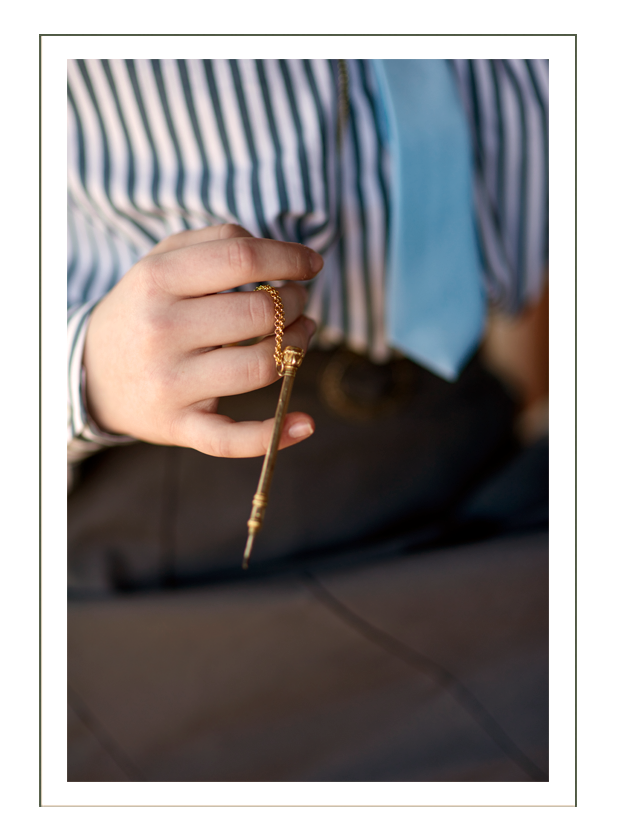
Hat
Unique to this character, time, and place, we started with a straw boater that had a shorter crown than modern versions, and added vintage grosgrain ribbon in grey and blue to match the accessories.
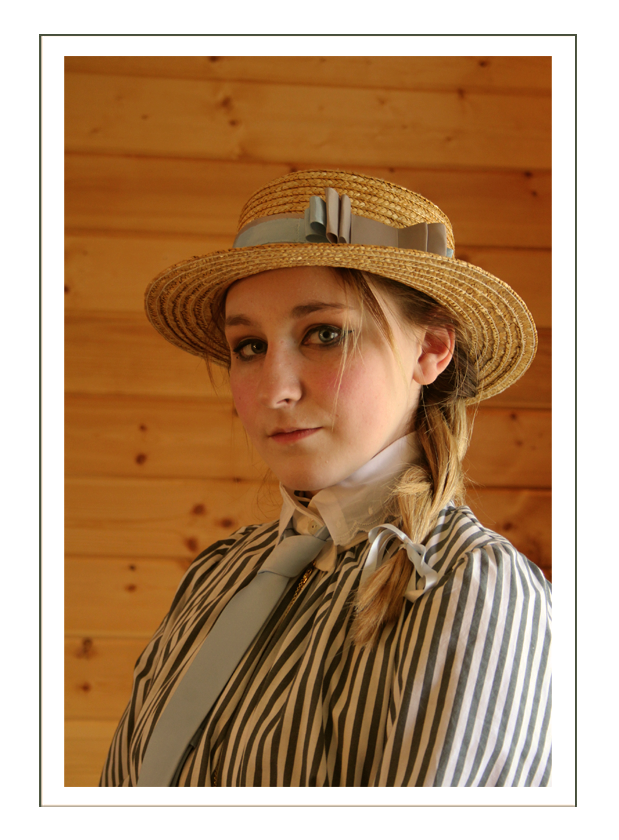
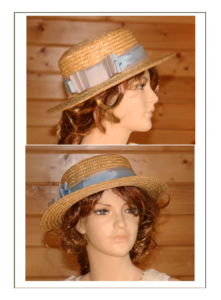

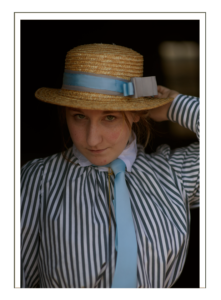

Necktie
We had to shorten this significantly as it was a men’s silk necktie. We also had to teach Bailey how to tie a man’s tie! Just one of the benefits of having a Silhouettes Costume! We love the quirky pink backing and the gorgeous 100% silk satin.
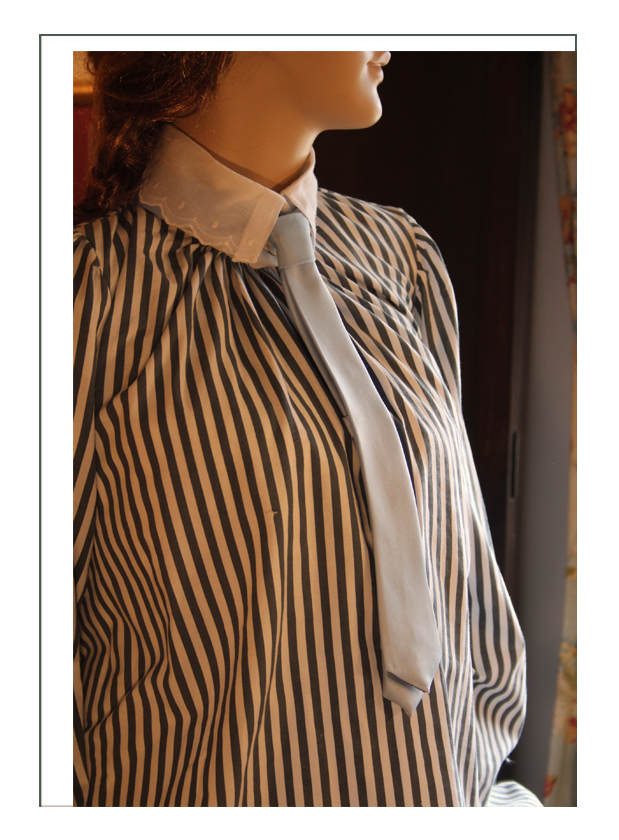

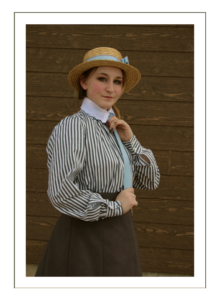

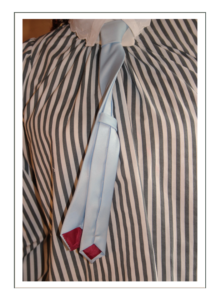
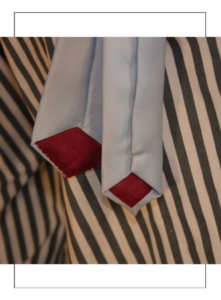

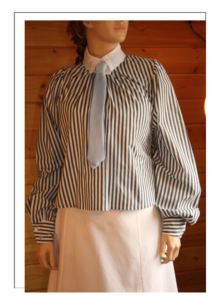

From fittings and photo shoots, Bailey had that new working woman of the 20th century sass and attitude!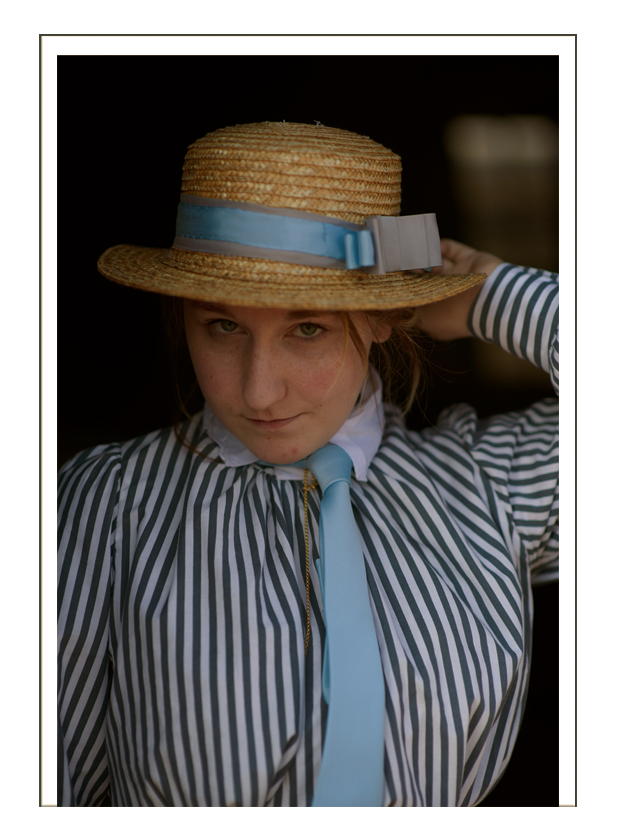
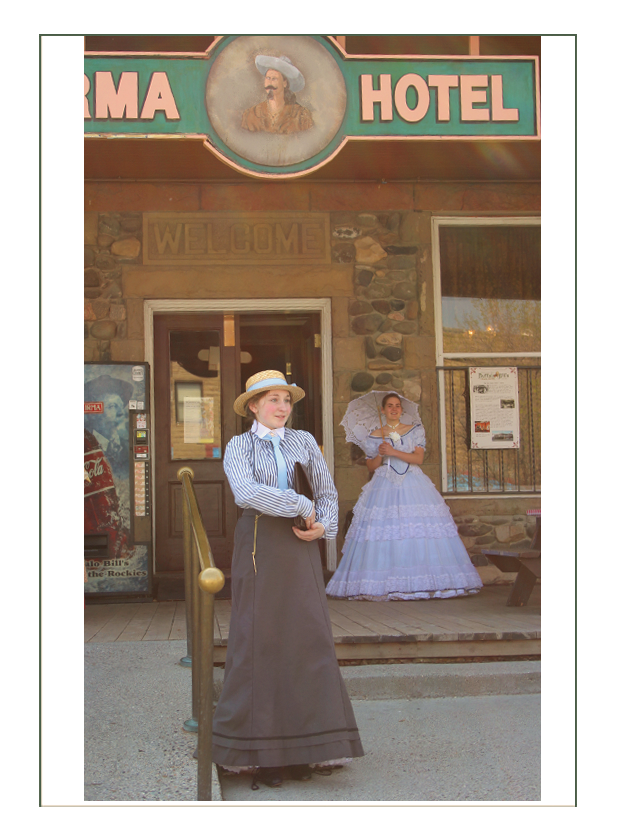
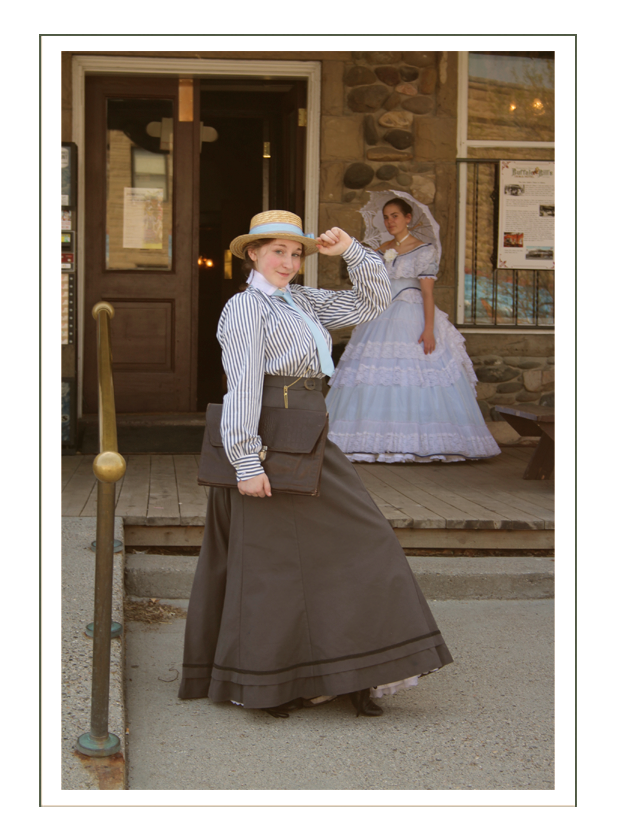

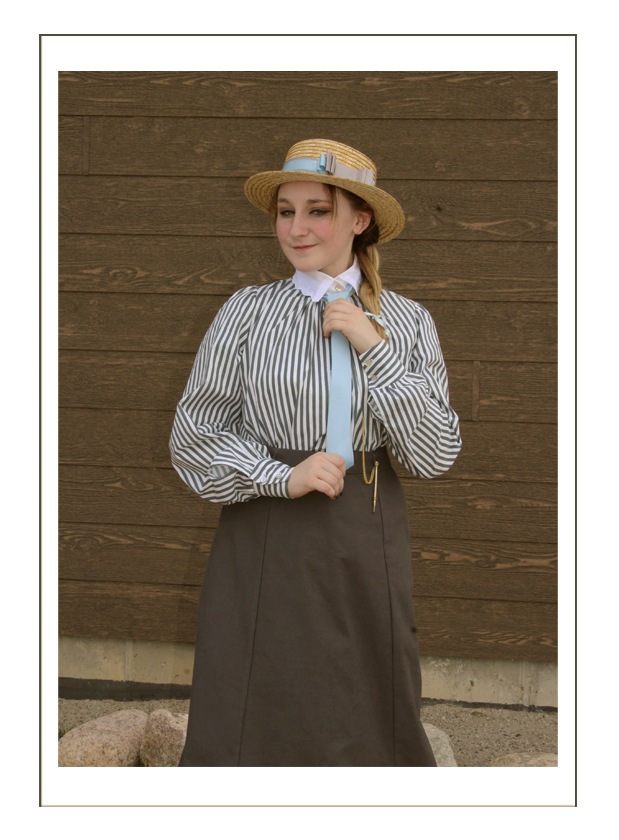
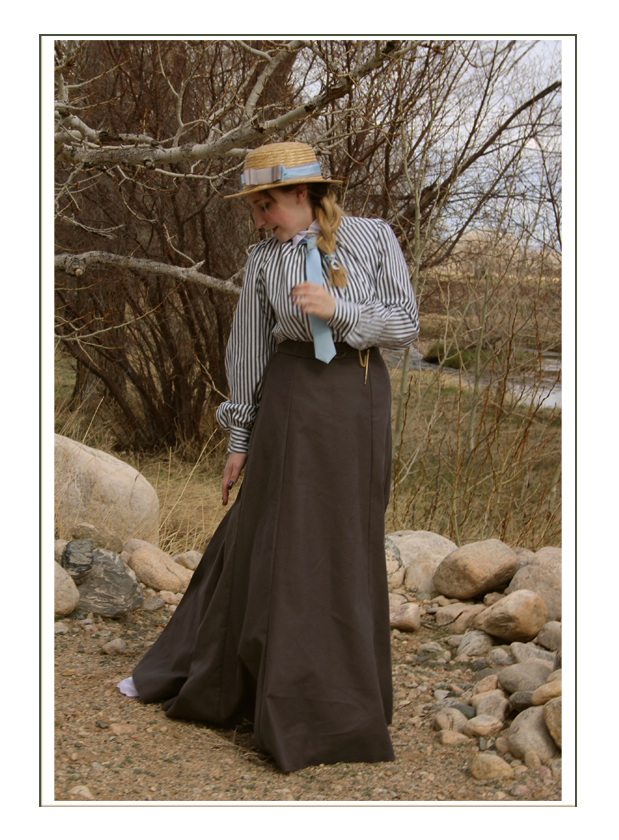



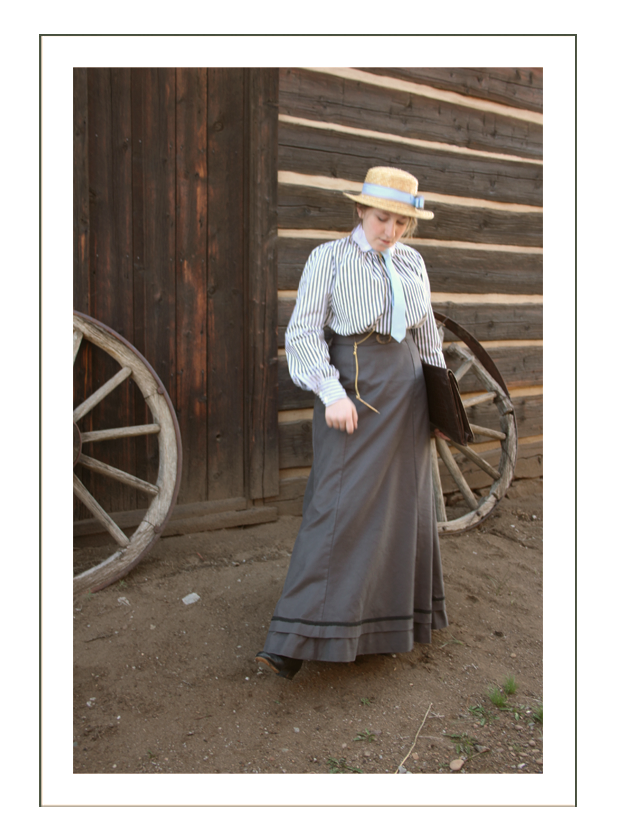
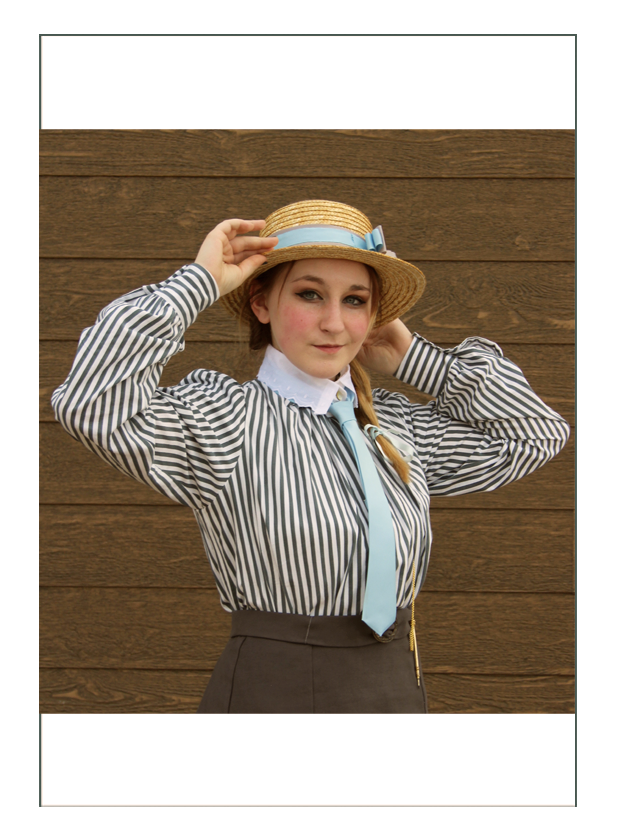
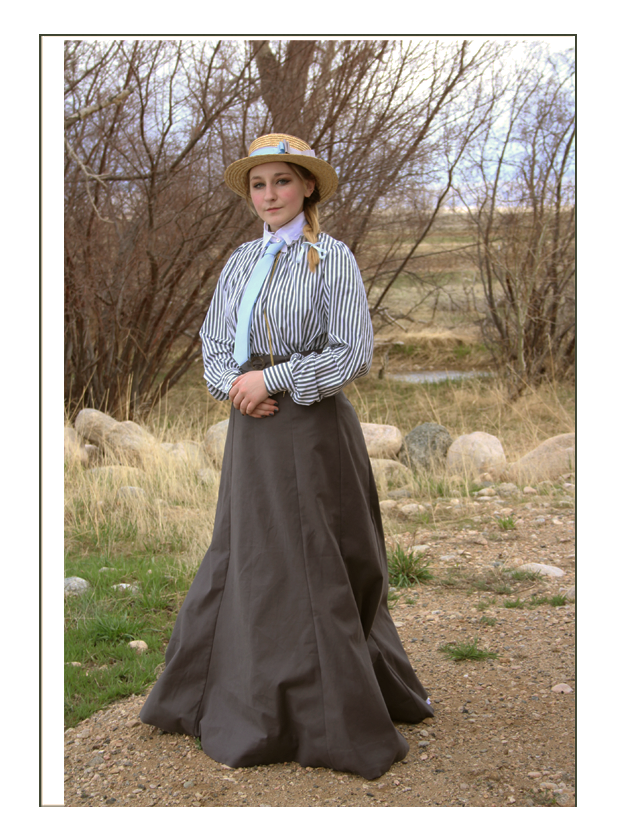
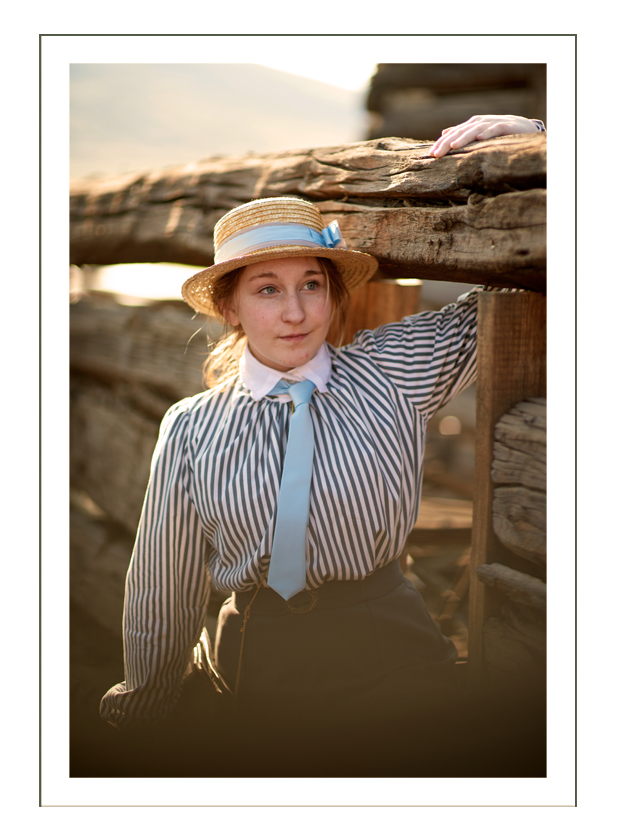

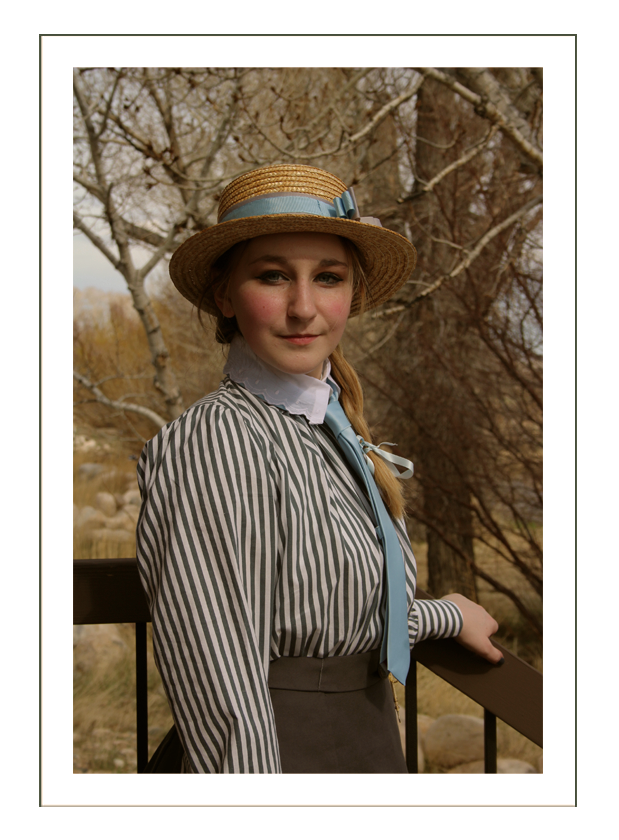
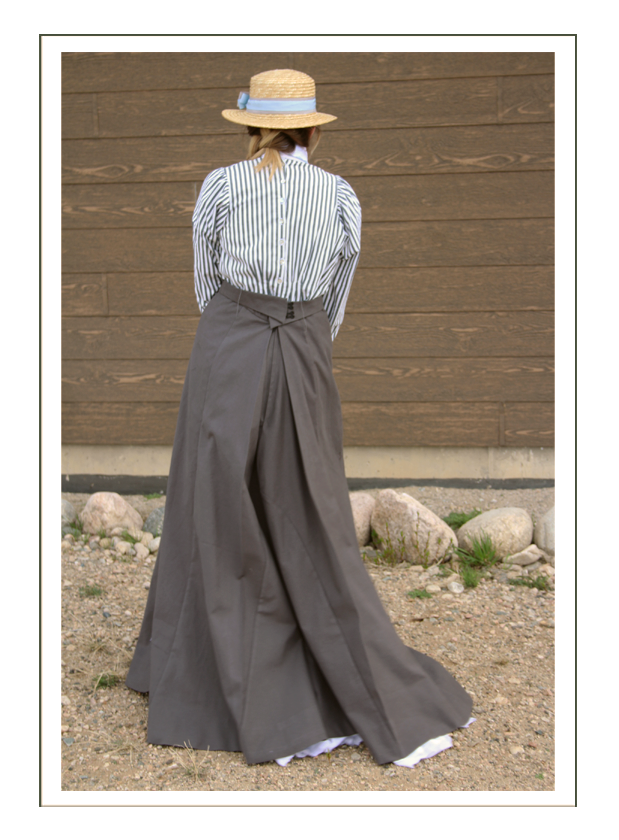

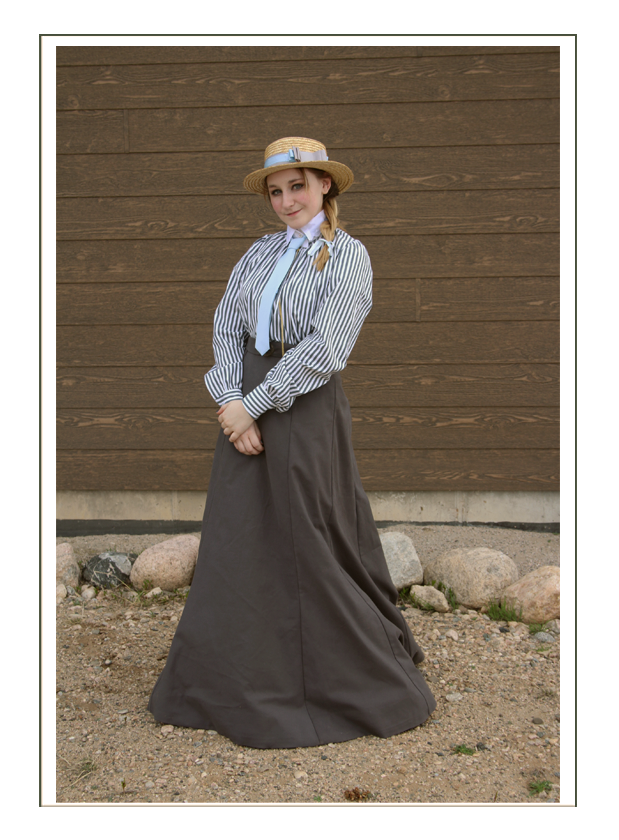
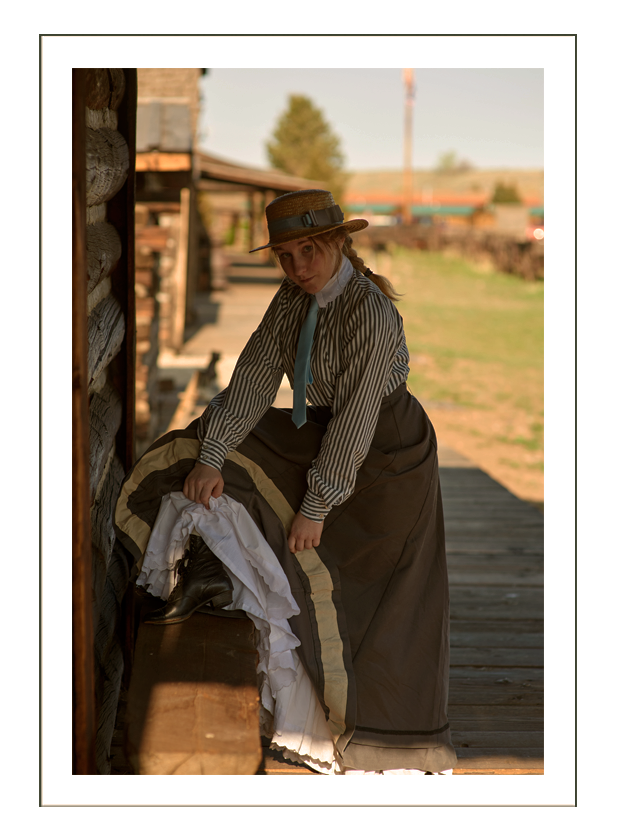
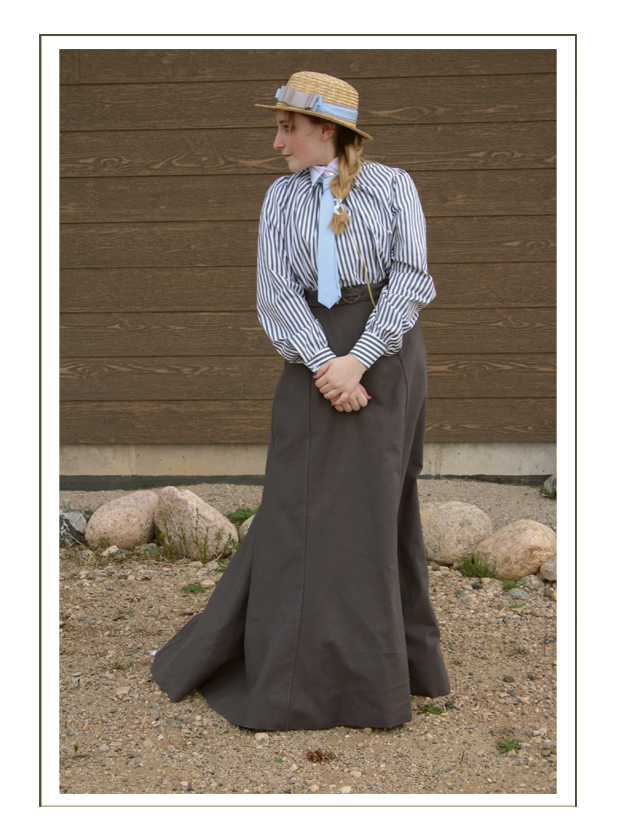
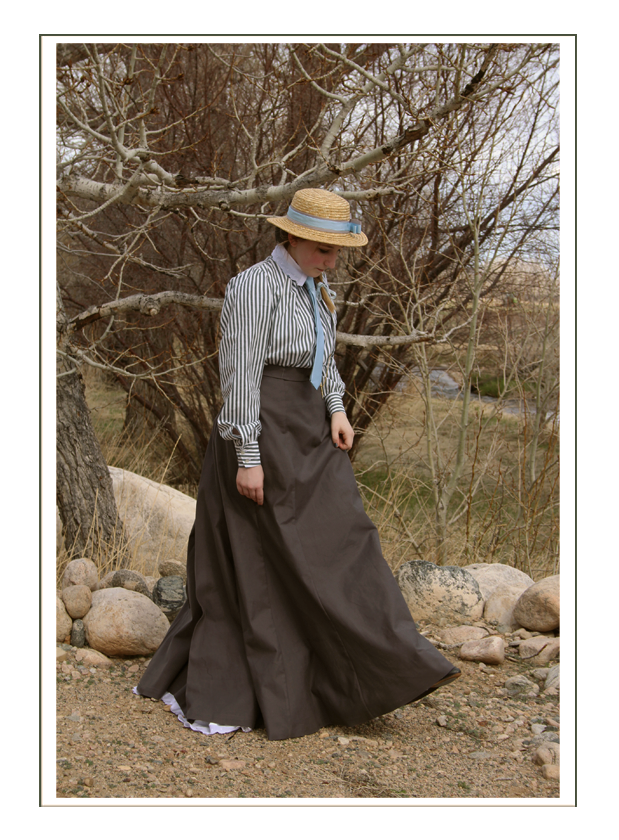
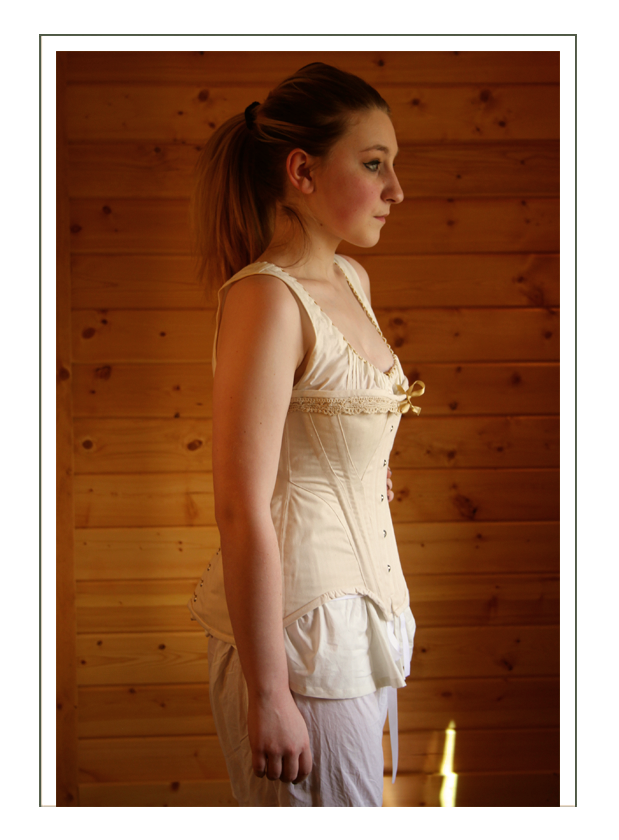
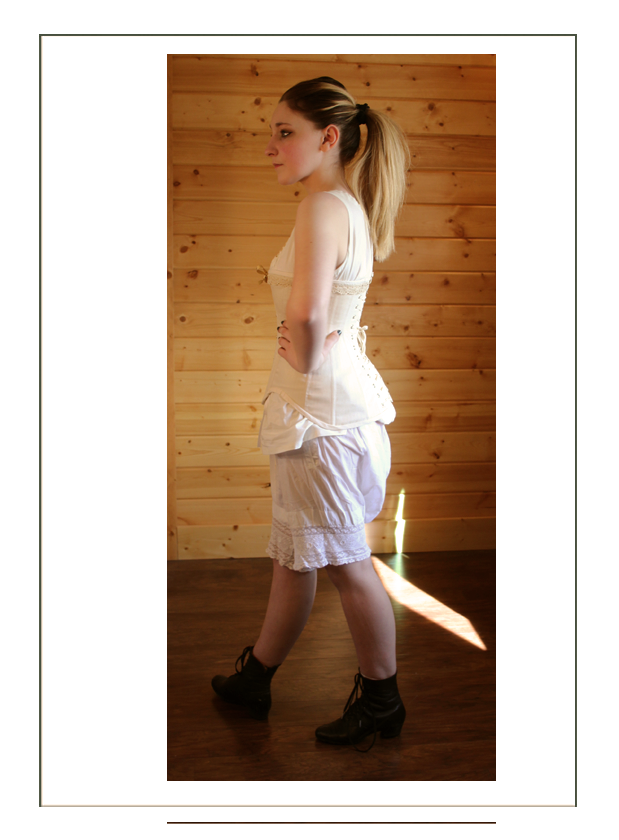
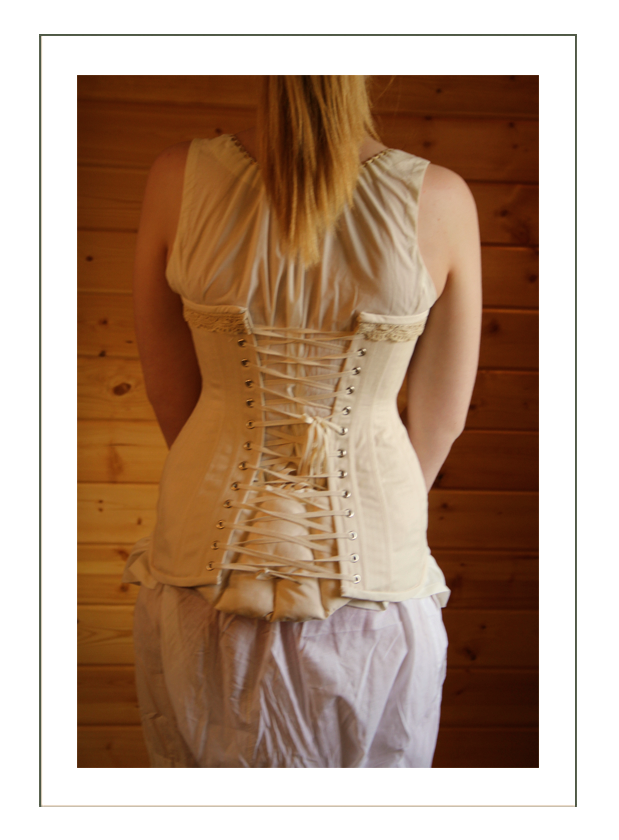
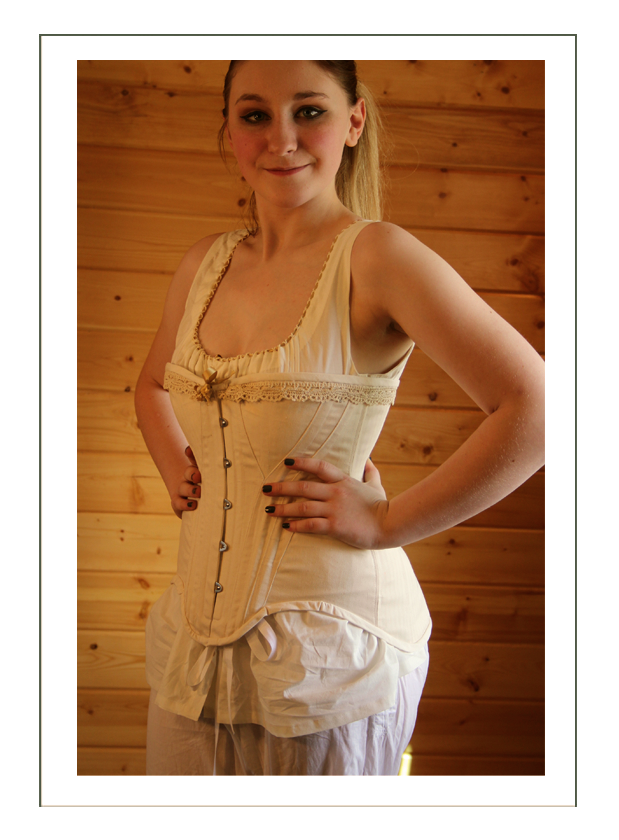
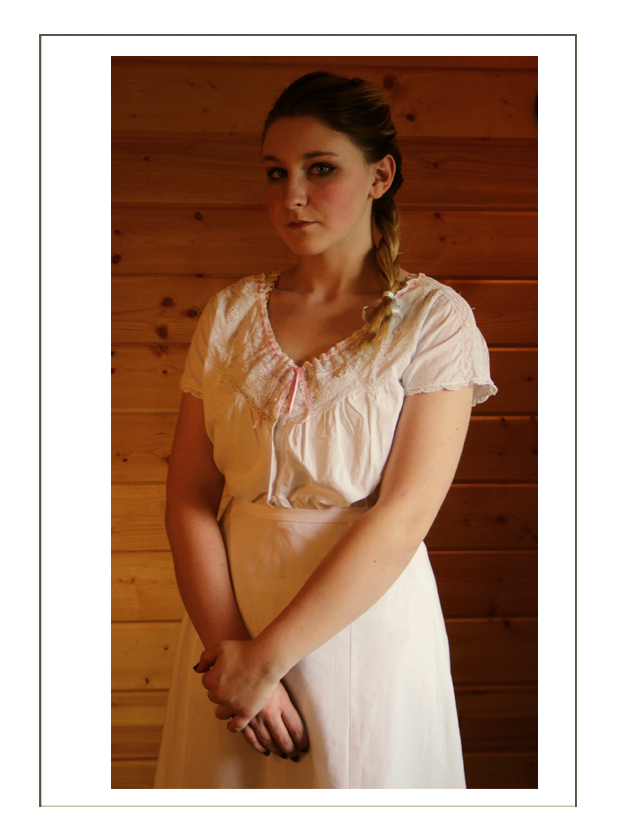

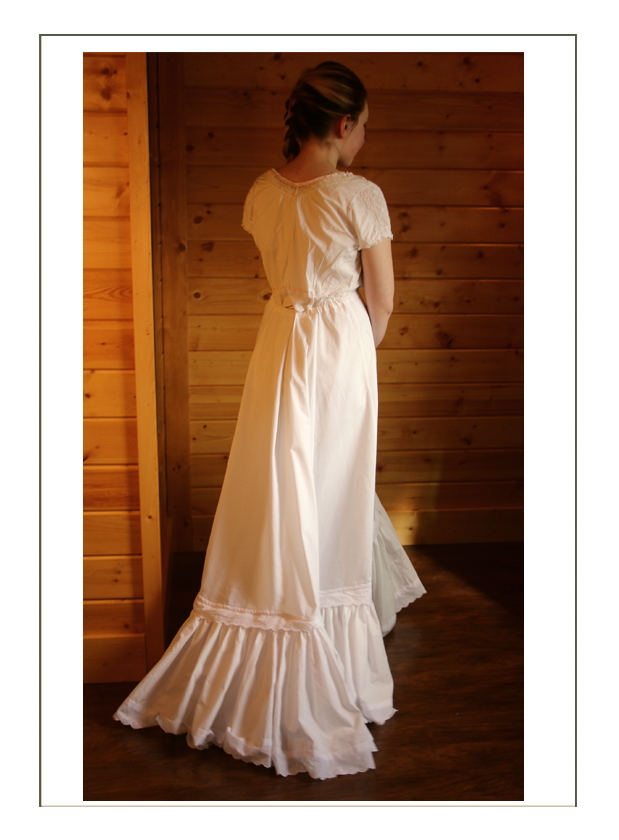
Click here to go to Bailey’s Historical Context Page (Next)
Click here to go to Bailey’s Fashion & Women’s History Page
